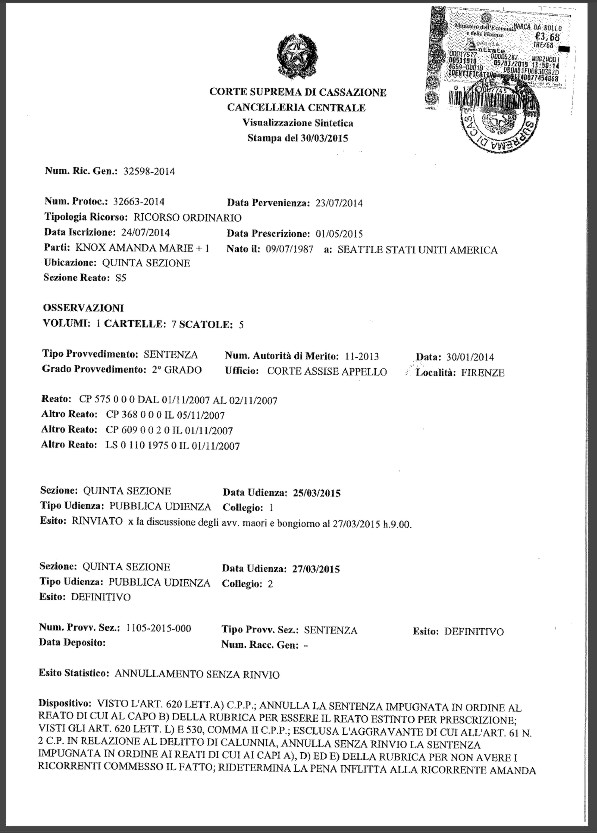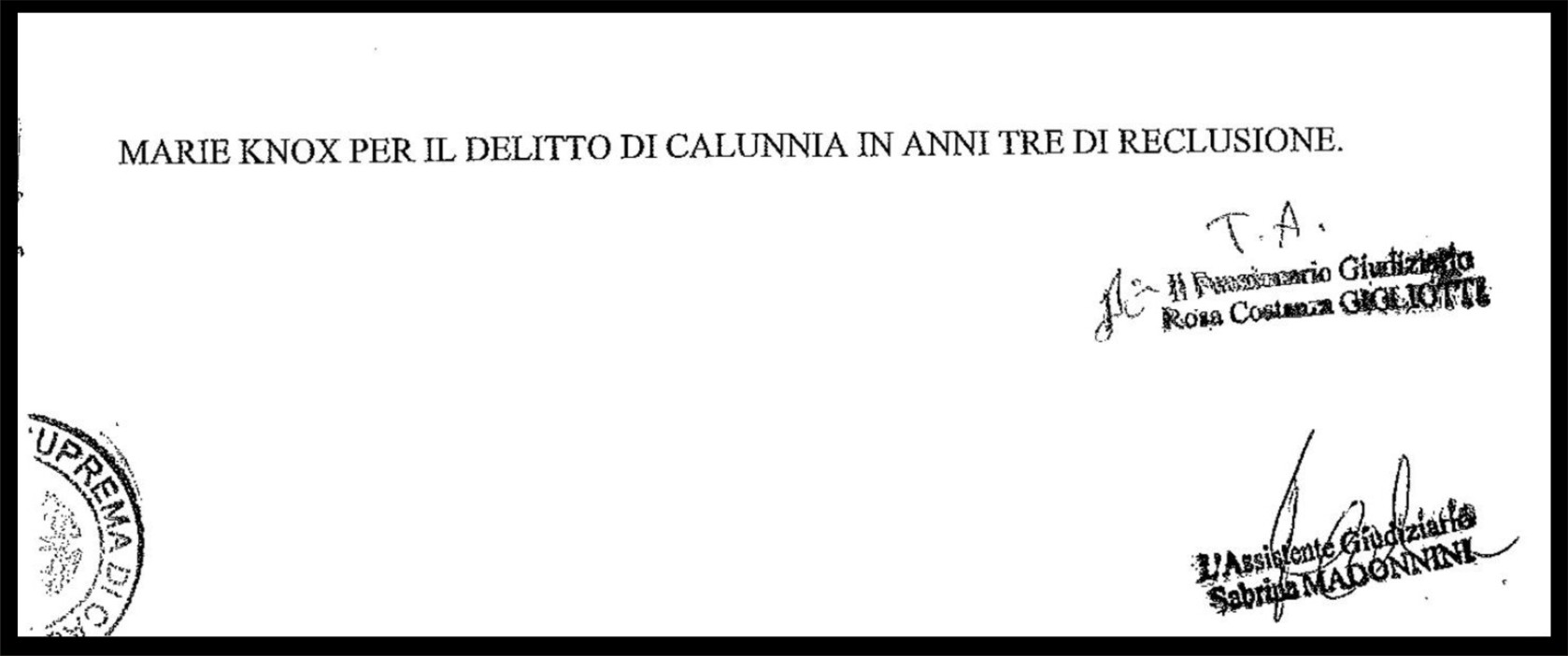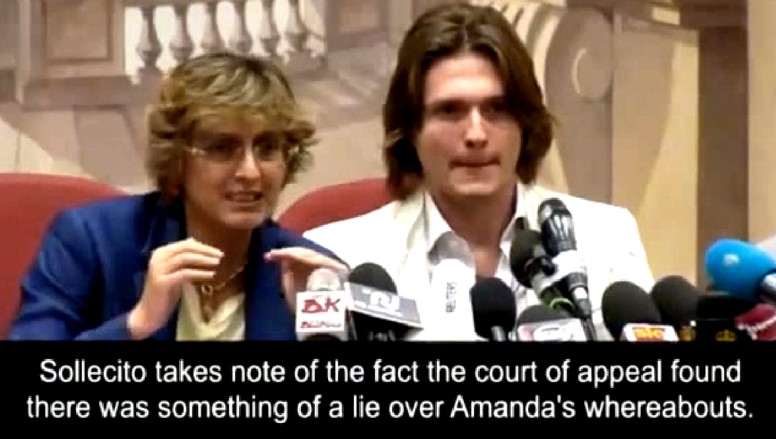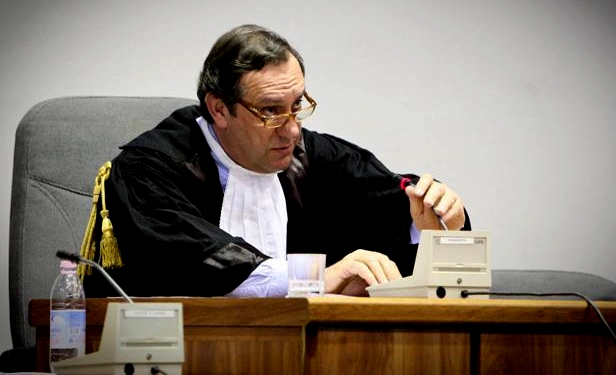
Category: The defenses
Tuesday, March 31, 2015
A Shaky Castle Of Cards At Best: The Long-Term Fight For Legitimacy Begins
Posted by Our Main Posters
1. Current State Of Play
As we so often hear, true justice has to be SEEN to be done.
At the end of the day it’s the legitimacy that counts - whether most informed people buy in - and the fight for this could play out over years.
Maybe that was on the minds of the tense Sollecito lawyers seen above after the surprise outcome was announced. Can those five judges make what seemed like a shoot-from-the-hip decision stick?
Back in 2009 the prosecution put on a very fine case, after Knox and Sollecito had failed six great opportunities in 2007 and 2008 to be let out. Prosecutors touched all the bases fast and, including what was presented in closed court, offered a very legitimate case for guilt which a unanimous panel of judges bought into.
Defense attorneys were rumored to be despondent and they never really hit a high point. Sollecito talks in his book about Maori having little conviction in him. Bongiorno was said to feel the same way and to not like Sollecito very much. Several times she was a surprise no-show in court. Ghirga was affable but uncomfortable, and sometimes he dozed off.
Was there under UK and US common law a strong case for an appeal? Under UK and US law an appeal must be requested, and a judge must decide. We have yet to read one opinion by a UK or US judge (and yes, they do write) that a case for granting an appeal was very strong.
In other words, under UK and US common law, the unanimous verdict and sentence would almost certainly have been it. All three would be serving their terms, and five years ago the whole world would have moved on.
In 2010 a clear case of judge-shopping occurred. Dont take our word for it - the senior and very experienced criminal-law Judge Chiari openly said he had been pushed aside as he resigned. He had been one of Italy’s finest prosecutors, and mentally and in terms of the law and grasp of the facts he was a giant compared to the bumbling ill-qualified Hellman, a business judge with only one other murder trial (a fiasco) in his past.
Throughout 2011 legitimacy swayed this way and that. The prosecutors began to smell a lot of rats and Prosecutor Comodi publicly said so. The chief prosecutor Dr Galati (who had just arrived from the Supreme Court) maintained that it didnt altogether matter, because he just knew the Supreme Court would throw a bum outcome out.
He was right. In March 2013 the elite First Section of the Supreme Court threw the bum outcome out, except for the part about Knox framing Patrick for which she had served three years.
The elite First Section handed the case back down to a new court, the Florence appeal court.
The Florence courts are staffed with very fine prosecutors and judges as they often handle national cases. Right now that court is handling a major investigation into national government corruption on a grand scale, Knox adulator Rocco Girlanda is one of those named.
National politicians under the gun like to knock chips off the courts given half a chance. Ex PM Berlusconi’s allies were said to have this as a fairly consistent aim. Any outcome ever in Rome which takes the Florence courts down a peg (as now) gets a lot of close looks.
Rumors abound in Rome that the president of the group of five judges and maybe one other felt the outcome of the Florence appeal court was the right one. If this is true, they may have never bought in and may now be only going through the motions with a forced grin.
The president of the court already issued an explanation of sorts. This has many in their peer group - the Council of Magistrates (which edged Hellmann out - refused him a promotion so he had nowhere to go) and all of the other judges and prosecutors in Italy - scratching their heads and wondering how in the Sentencing Report the circle can be squared.
Meanwhile on other fronts legitimacy is now on the line. Sollecito is due back in court in Florence on false claims in his book on 30 April. Knox’s calunnia trial is due to resume again shortly in Florence with expanded charges targeting false claims in her book. The Oggi trial for quoting false claims in Knox’s book has a testimony session 16 June.
The final verdict and sentence maybe cannot be wound back and their chances of serving more time for murder and a sex crime are remote. (Knox could be sentenced to more time at her second calunnia trial).
But the circumstances in which they are walking around may come to look very odd. The Supreme Court actually can be sued now for an inexplicable outcome, and made to take another look.
The President of the Italian Republic (who is the ultimate head of the justice system) can be petitioned to step in. Political parties like Beppe Grillo’s astonishingly popular Five Star Movement (said to be already snooping) have a lot of power to make things come unstuck. .
So, in the months and even years ahead, this is clearly going to be a long game, with legitimacy as the ultimate prize. Sorry, Sollecito and Knox, but it aint over till the fat lady sings.
2. New Developments Indicate Concern
Seven developments in this race for legitimacy points suggest that the RS and AK camps are very concerned about it, and are not at all sure what to do.
1) Francesco Sollecito is quoted as asking Guede to endorse the outcome. Guede already said the opposite although his main statement was in the annulled Hellmann appeal. Aviello is still on trial by the way, in 2011 he pointed at the Sollecitos as not playing by the rules.
2) Francesco can be sure Guede wont actually speak out, as he will have his own legal action in the works to get his case reviewed. That could go to another section of Cassation and if they rule differently really open a can of worms.
3) Sollecito has spoken out heatedly and vengefully on Italian TV in effect wanting the Italian state to pay him off in a big way and everybody else to believe him or shut up.
4) Bongiorno publicly disagreed with him and she said such actions need to be considered with a cool head down the road.
Report on the Il Tempo website.
Lawyer Bongiorno. “In the coming days we will evaluate request for compensation,” announced Raffaele’s lawyer, Giulia Bongiorno, after the acquittal of the young man for the murder of Meredith Kercher.
“There are feelings of revenge in Sollecito’s soul,” added the lawyer today. “We will wait for the motivations. Not thrash/lambaste those who might have done [Sollecito] wrong.”
“We’ll see if there were errors and what measures and initiatives could be undertaken. Civil liability - she concluded - is a serious institution that should not be exercised in the spirit of revenge.” (Translation by Guermantes on Dot Net)
5) Barbie Nadeau quotes an Italian expert who says that because RS and AK both provably lied to the police and led them astray, any claim for compensation could be dead on arrival.
Bongiorno may already realise this. She may also realise that having a litany of lies read out hardly advances their quest for legitimacy points.
6) This is previous news. Bongiono passed on being the lead lawyer in Sollecito’s book case. Nothing could cost legitimacy points more than a loss at the Florence trial on the false claims in RS’s book.
Note that at the moment few Italians - including Cassation - know what is in the book. It is possible Bongiorno wants to make herself scarce before the legitimacy points just gained head down the tubes.
7) The Fischer disinformation group (see posts coming up) has moved from shrill to frantic harrassment mode.
Let’s guess. Bongiorno and the other Perugia lawyers would think that a really bad idea, as Knox and RS are still on trial and abuse wont make that go away. Legitimacy if any will come not from strongarming but from cool heads.
Here’s betting all 4 main lawyers and both families would like to keep RS and AK on a really short string. Nothing will screw them like yet another of their open spats.
Right up to last week RS was still distancing himself a mile from Knox.
Cassation Appeal By RS And AK Against Nencini: Cassation Rules Not Enough Evidence NOT Innocence
Posted by Machiavelli
1. Dispositivo issued by Judge Marasca
This statement by Dr Marasca was dated 30 March 2015. An English translation and analysis is below the document image.
Dispositivo: VISTO L”˜ART. 620 LETT.(A) C.P.P.; ANNULLA LA SENTENZA IMPUGNATA IN ORDINE AL REATO DI CUI AL CAPO (B) DELLA RUBRICA PER ESSERE IL REATO ESTINTO PER PRESCRIZIONE; VISTI GLI ART. 620 LETT. (C) E 530, COMMA II C.P.P.; ESCLUSA L’AGGRAVANTE DI CUI ALL’ART. 61 N. 2 C.P. IN RELAZIONE AL DELITTO DI CALUNNIA, ANNULLA SENZA RINVIO LA SENTENZA IMPUGNATA IN ORDINE AL REATI DI CUI AI CAPI (D) ED (E) DELLA RUBRICA PER NON AVERE I RICORRENTI COMMESSO IL FATTO; RIDETERMINA LA PENA INFLITTA ALL RICORRENTE AMANDA MARIE KNOX PER IL DELITTO DI CALUNNIA IN ANNI TRE DI RECLUSIONE.
seen art. 620 lett. A) c.p.p.;
annuls the impugned verdict as for the charge in count B) of the indictment section because the time of limitation of the offence has expired;
seen articles 620 lett. L) and art. 530 second paragraph of c.p.p.;
excluding the aggravating circumstance under art. 61 n.2 c.p. in regard to the felony of calunnia, annuls the impugned verdict without remand as for the crimes charged in counts A), D) and E) of the indictment section due to the recurrents not having committed the crime; re-determines the penalty inflicted to recurrent Amanda Knox in three years imprisonment for the crime of calunnia.
2. Two Warnings
Warning 1
(1) The statement “because they did not commit the crime” does not imply a finding of innocence under Italian law; and when the art. 530.2 is mentioned there is no possibility of a finding of innocence;
(2) There are major legal blunders: the Cassazione is not allowed to make any finding of facts of any kind, it does not assess evidence directly, and it may not mention 530.2.
It could not have re-determined the penalty for calunnia if the penalty was already definitive. Here unusually the verdict was definitive but not the punishment, as Nencini increased the sentence from the 3 years imposed by Hellmann to 3 and 1/2 years, having been asked by the First Chambers to consider whether there was a teleological link with a murder conviction. Having annulled the conviction for murder the Fifth Chambers wiped out the extra 6 months.
Warning 2
At the end of the 2015 Afterword of Knox’s “If I did it” paperback edition, the Creative Writing student writes:
Minutes later Carlo Dalla Vedova, one of two Italian lawyers, called.
“Does “˜acquitted’ mean not enough evidence to convict?” I asked him. Or did they find us innocent?”
“They find you innocent. Amanda!” he said. “It’s the best result possible!”
That is untrue. Readers may like to be warned that this is the latest lie. Either by Knox or Dalla Vedova. See Warning 1.
In fact Cassazione explicitly mentions 530 paragraph 2, which in Italian law means “not enough evidence” but not “finding of innocence”.
Such annulment is a legal blunder since Cassazione may not do any fact-finding in the merit.
However, as a court finding, 530.2 is finding of doubt, therefore the contrary of what Knox conveys to her readers.
Thursday, October 16, 2014
Knox, Tied In Knots By Her Own Tongue: Translation Of The 17 Dec 2007 Interview With Dr Mignini #4
Posted by Machiavelli, Catnip, Kristeva
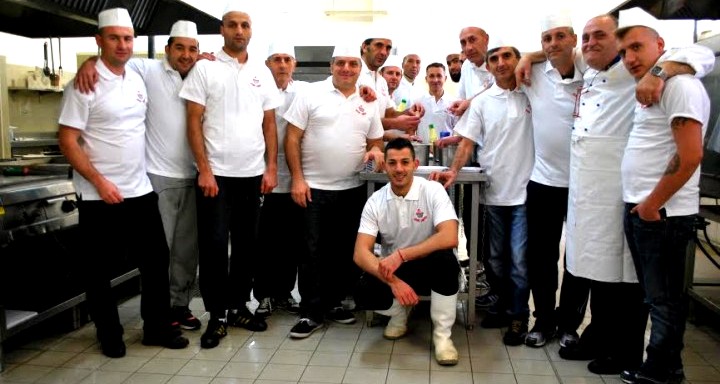
Inmate-chefs at Capanne Prison, from which Knox was making a bid for release
1. Getting Up To Speed On This Fourth Post
How much serious questioning was Knox subjected to prior to this voluntary interview six weeks after her arrest?
In fact, none. In the early days of November, after Meredith was found dead, she had several less-formal “recap/summary” sessions with investigators on possible leads (as did many others), which the defenses conceded without argument at trial were simply that and no more.
So these were the first serious questions put to Knox - politely, and Knox is essentially not argumentative throughout
The transcript was in the evidence pile and all judges except Hellmann seem to have studied it hard. This was also the first-ever interview of Knox by Dr Mignini, as prosecutor appointed to the case. He had seen her twice at the house and heard her at her strong insistence early on 6 November.
But they had never before really talked.
Prior to this, Knox had already emanated over a dozen differing versions of what she wanted to claim took place and the police and prosecutors and Supervising Magistrate Claudia Matteini had tried to make sense of those.
2. Our Translation Of Approximately The Fourth 40 Minutes
This is the fourth 40 minutes of the voluntary interview which lasted in total about three hours. For a full understanding it would really be best to read (1) our first post and comment thread and (2) our second post and comment thread. and (3) third post and comment thread.
Transcript of Interview 17 December 2007: Statement of Interview Of Ms Amanda Knox (cont)
PM Mignini: After having talked, after you were heard at the Questura, did you go away or did you wait?
Knox: The first day I was questioned I was there for hours”¦ maybe 14”¦
Interpreter: The first time it seems to her that she had been there a very long time, 14 hours
PM Mignini: But questioned
Knox: No, maybe they questioned me for 6 hours but I stayed at the Questura a very long time”¦
Interpreter: It must have been more or less 6 hours that Amanda was questioned but staying in the Questura must have been about”¦
PM Mignini: But was there”¦ were you in the waiting room?
Knox: Yes the whole time together with everyone else we were there in the waiting room”¦
Interpreter Yes, yes together with the other ones
PM Mignini: And who were the other people?
[82]
Knox: The housemates, and later others arrived”¦ After quite a long time our neighbors arrived, after a while some people Meredith knew arrived, her friends
Interpreter: Her housemates and then other people who arrived later, the neighbors after a while”¦ and after, Meredith’s friends arrived, the people Meredith knew”¦
PM Mignini: But did you speak to them? Did you exchange any confidences?
Knox: Yes we were all there and I said “it appears that Meredith’s body was found in a closet”
PM Mignini: Who said that?
Knox: I remember talking to her friends and I remember telling them that it appeared the body had been found inside a closet”¦
Interpreter: She remembers having said it to Meredith’s friends
PM Mignini: But friends, who? You must tell us the name”¦ a name even just the name”¦
Knox: I remember having talked to Sophie”¦ But I don’t know the name of the other friends
PM Mignini: A certain Natalie? From London
Knox: The name sounds familiar but I don’t think I could recognize her face
Interpreter: She can’t tie the name to her face but”¦
PM Mignini: And what were you saying? What kind of comments were you making?
[83]
Knox: I told them what I knew, I told them that I had arrived home and found the door open, and told them what I knew”¦
Interpreter: She told what she knew that she had arrived home and found the door open
PM Mignini: Did you ever see, did you see in those moments the wound on Meredith’s neck?
Interpreter: Up to the moment?
PM Mignini: In that moment.
Knox: I never saw Meredith dead, I never saw her dead body”¦
Interpreter: No, she never saw her dead
PM Mignini: Ok, but was there anyone that night who said, anyone who said that she had died quickly? Did someone else say that she must have suffered for a long time”¦ was there anyone who said this?
Knox: Nobody of the people I talked to knew what had happened”¦
Interpreter: No, none of the people she talked to said something”¦ knew what had happened
PM Mignini: Did you come to know, did you ever come to know, and if yes, when, in what moment, Meredith had died”¦ that is, if Meredith’s death was immediate or if it was prolonged, if there was a death agony”¦ if yes, when did you find that out?
Knox: The only time when I heard of this was when Luciano [Ghirga] was describing the wound and how deep it was”¦ What kind of wound it was and he said “maybe she died slowly because no big vein had been struck”
Interpreter: So, the first time you had heard talking about the wound and how she died”¦ when was it with Luciano?
Lawyer: The morning of the 8th
[84]
PM Mignini: So, after the 6th…
Lawyer: The morning of the 8th
PM Mignini: The morning of November 8th
Lawyer: After the arrest validation [hearing]
Interpreter: And there she found out that no vital vein was directly struck and therefore”¦
PM Mignini: You say that she came to know on the 8th from the lawyer.
Lawyer: From the lawyers.
PM Mignini: From the lawyers, sorry.
Lawyer: We always came all together
PM Mignini: Either one or the other [of you] could have told her”¦ so”¦ [talking to Knox] I formally notify [for the record, a contradiction] that an Erasmus student and a colleague of this student, they said, on this past December 10th that on the night of the second in the Questura, while having”¦ a girl called Natalie, I won’t tell you her last name but she”¦ she was a friend of Meredith, she had noticed that you were talking at length with Sollecito, and at a certain point, in response to a comment made by one of these girls that they hoped Meredith had died without suffering, you instead said ” with those kind of wounds the death would not have come fast and that therefore Meredith must have died after a certain period of time”. I’ll reread it to you if you’d like, ok?
Knox: The police told me that her throat was cut, and what I know about that topic, I mean when they cut your throat, it is terrible and I heard that it’s a horrible way to die”¦
Interpreter: Yes the police had told her that Meredith’s throat was cut and what Amanda knew is that it’s an agonizing way to die”¦
[85]
PM Mignini: But this is something we found out after, we too found it out only later”¦ not right away”¦
Knox: The police told me that her throat had been cut.
Interpreter: The police had told her that her throat had been cut.
PM Mignini: Who from the police? Excuse me I’d like to know”¦ cutting the neck, it can happen in many ways, vital veins can be struck and might also not be struck, therefore one thing is about cutting the throat, and another is about the way how to cut it and therefore make it so that the death occurs instantaneously, or cause a death with agony. On the evening of the second, if it’s true, according to these results, on the evening of the second you knew that, with those kind of wounds, she must have suffered an agony”¦ and the police didn’t know that”¦
Knox: I thought that a death by cutting the throat was always slow and terrible”¦
PM Mignini: The autopsy was made on the fourth, two days later
Interpreter: What she thought was that cutting the throat was always a slow death in general
PM Mignini: It’s not like that”¦not necessarily”¦ anyway, who from the police told you about the neck wound? Tell us.
Knox: It was probably the interpreter”¦the first interpreter was the person I talked to the most”¦ all information I had came more or less from him”¦
Interpreter: Probably the translator/interpreter
PM Mignini: Therefore, therefore he told you while you were being heard”¦
Lawyer: She was in there 12 hours
[86]
Knox: When I was in there I was talking to the police and they told me that her throat was cut”¦ the whole conversation was between me and the interpreter. It was him who must have told me, a long time has passed but I think it was like that”¦
Interpreter: Directly from the interpreter, indirectly from the police
PM Mignini: So [it was] when you were questioned. Not before.
Interpreter: No, before she was questioned she didn’t know how she was”¦
Knox: No, when I was home the way she died”¦
PM Mignini: Before being questioned”¦ you were questioned until 15:30, until what time have you been heard? You were being heard since 15:30, until what time were you being heard?
Knox: I don’t know it was a long questioning”¦
Lawyer: She had been heard in the presence of an interpreter, maybe the interpreter”¦
PM Mignini: It was D’Astolto”¦ Fabio D’Astolto
Lawyer: The interpreter was present from the beginning or only from the questioning onwards?
PM Mignini: Yes, well he was a policeman acting as an interpreter, translating. Fabio D’Astolto. Assistant D’Astolto. When and how, in what terms did D’Astolto express himself, this translator what did he tell you?
Lawyer: When?
PM Mignini: When and what did he tell you
Knox: I don’t remember when but I asked him how she died
Interpreter: She doesn’t remember when but she asked him how she was killed”¦
PM Mignini: And he pointed out to you the wound on the neck. The wound on the neck and that’s all. Fine. This translator.
[87]
Lawyer: [to the Prosecutor] You referred to an Erasmus student who had said that on December 10th. Ms. Natalie would have said this.
PM Mignini: Yes
Lawyer: And is the Erasmus student indicated [in the records]?
PM Mignini: It is indicated
Lawyer: Do we have a name?
PM Mignini: Capruzzi, Filippo and the other one is a certain, a colleague of his, Chiara, Maioli.
Lawyer: So it was two Erasmus students
PM Mignini: Two Erasmus students who confirmed this confidentiality from this English girl. Some”¦ this is the December 10th hearing report”¦ ok
Lawyer G. She clarified if she had talked with the interpreter, with someone before”¦
Lawyer C. We have clarified that the interpreter was not an interpreter but was a police officer who speaks English and that apparently was present from the beginning and therefore at this point…
PM Mignini: Wait.. one moment”¦ did you, did you”¦ did you see this person who was translating at the house?
Knox: No
Interpreter: No
PM Mignini: Perfect
Lawyer: She was approximately 12 hours in the Questura and at some time she heard the first… let’s call it questioning but it was a long time, and before the questioning she heard of this wound on the neck, is that right?
[88]
PM Mignini: During the questioning, you said before, during the questioning so much as this policeman translator was present, therefore”¦ no I’m very sorry, who did you hear this from? The translator? The policeman
Interpreter: About the wound? The first time?
PM Mignini: The wound
Knox: I think so
Knox: The first time?
PM Mignini: Yeah
Interpreter: I think the interpreter the first time
PM Mignini: And it would be this D’Astolto”¦ so this D’Astolto told you, please excuse me you told me this “it was D’Astolto” now”¦ therefore this D’Astolto told you this during the course of the questioning?
Knox: I think so”¦
Interpreter: Yes, she thinks so
PM Mignini: Ok, one more thing, so the”¦ you did, the morning of the”¦ actually no, the night between the fifth and the sixth of November, you did, let’s say partially modify your previous declarations, so then you modified your previous declarations and you made a specific accusation against Patrick Dia Lumumba known as Patrick. You said that you were supposed to meet with Patrick, that you met with Patrick at the basketball court of Piazza Grimana, that you went to Meredith’s house, to your house, and then he had sex with Meredith, then you heard a scream and you accused him even if in terms you say “confusedly” of killing Meredith. Isn’t that so? Why did you make this accusation? “¦ Now remember, I was hearing you, I was present, you were crying, you were
[89]
profoundly upset, and you were as if relieved when you made this statement.
Lawyer: Maybe she was stressed?
PM Mignini: Well, stressed or not, in any case she was very she made these declarations
Lawyer: You asked her a question “Why did you make these declarations”?
PM Mignini: Well I also have to”¦
Lawyer: Eh these are opinions
PM Mignini: I am saying that you made a declaration not in a detached way, in other words in a very involved manner, why did you make these statements?
Knox: I was scared, I was confused, it had been hours that the police that I thought were protecting me, and instead they were putting me under pressure and were threatening me.
Interpreter: She was scared, she was confused, it had been hours that the police were threatening and pressuring her.
PM Mignini: Yes, tell me, go on
Knox: The reason why I thought of Patrick was because the police were yelling at me about Patrick”¦ they kept saying about this message, that I had sent a message to Patrick”¦
Interpreter: The reason why she thought of Patrick was because the police was asking her who was this Patrick to whom she sent, with whom there was this exchange of messages, they were asking her insistently.
Knox: That was the worse experience of my life
Interpreter: The worse experience of her life
[90]
Knox: I had never been more confused than then
Interpreter: She had been so confused or scared
PM Mignini: But in the following memoriale [spontaneous statement around noon 6 November] that you wrote before going to prison, basically you don’t retract this accusation. Even if in terms, still in terms let’s say of uncertainty, between dream and reality, in other words in such a way “¦ still you didn’t “¦ I believe that in this memoriale you say “I still see this image in front of me” and then you see yourself while hearing it, you say that in that first memoriale you wrote “you hear Meredith’s screams and you put your hands over your ears”. Why do you have this image? Your ears”¦ the scream”¦ it’s not like it’s changing much after all isn’t that so?
Lawyer: No, but she says she was very confused”¦ she was under a lot of stress
PM Mignini: Yes, but why does it basically remain the same, this one”¦
Knox: Yes, I imagined these things”¦
Interpreter: Imagined this scene
Knox: I was so scared and confused
Interpreter: I was so scared and confused
Knox: that I tried to imagine what could have happened. The police told me that I was probably not remembering well. So I thought of what could be another answer and therefore I imagined it”¦
Interpreter: She tried to think of what could have happened since the police was saying that probably she didn’t remember well. And therefore she imagined this scene, trying to think how it could have happened
PM Mignini: Well, you, I just tell you, I tell you only that this Dia Lumumba, this Patrick, only comes up in your statements, he wasn’t, he has never been indicated previously in the slightest, I mean why did you, why did you almost feel…
[91]
...forced to, so you say, to give this name? While this name had never been, you had never mentioned him previously”¦ in the statements of the 2nd, the 3rd”¦. Why only at a certain point di this Patrick pop up? I’m telling you, do you realize”¦ excuse me, eh? “¦ excuse me”¦.
Knox: They were telling me “why did you send this message to Patrick, this message to Patrick!”
Interpreter: Because they were always insisting about this message to Patrick and because”¦
PM Mignini: Well because there’s the message so [it’s] the message but it’s just that, it’s not that there was an attitude, I mean it’s not like there was any reference to a message according to what emerges from the statements. In fact there was a message that you”¦ since there had been an exchange of messages right before the time of the murder between you and this person it’s normal that the police would want to know why, what this message meant, this”¦ therefore it’s not something”¦ why did you threw yourself in this kind of”¦ ? While you had, you had the possibility to”¦?
Knox: Because I thought that it could have been true
Interpreter: Because she thought it could have been true”¦
PM Mignini: It could have been true?
Lawyer: Why?
Knox: When I was there, I was confused”¦
PM Mignini: [to the lawyers, ed.] No, no, excuse me, at this point no, I’m sorry. Not the lawyers. The defense can intervene against me but against the person investigated…?
Lawyer Ghirga: But there was no question”¦ Prosecutor there was no question
PM Mignini: It could be true. What does it mean?
[92]
Lawyer Ghirga: There was no question
PM Mignini: What? I am asking the question.
Lawyer Ghirga: Then ask it.
PM Mignini: What does it mean, how “˜could it be true’? What?
Lawyer Ghirga: What could be true?
PM Mignini: Excuse me, lawyer
Lawyer Ghirga: It’s like the phone call with her parents
PM Mignini: What could be true
Lawyer Ghirga: It’s like the phone call with her parents
PM Mignini: “¦Lawyer Ghirga”¦ what”¦?
Lawyer Ghirga: [seems to Knox] What do you want to say then? Let’s ask her”¦
PM Mignini: Excuse me, I am asking the questions, I am asking them now
Lawyer Ghirga Yes of course
PM Mignini: Then after you can”¦ I am asking her”¦
Lawyer Ghirga: Yes of course, we will ask them too”¦
PM Mignini: Lawyer”¦ she is saying “it could have been true””¦
Lawyer: What?
PM Mignini: “it could have been true”. She was telling me why did she accuse Lumumba of this fact? “It could have been true” is what she answered. Gentlemen, here”¦
Knox: I said it because I imagined it and I thought that it could have been true”¦
Interpreter: She said because she had imagined it and therefore she thought it could have been true.
[93]
PM Mignini: Look, listen”¦ listen, why did you imagine it?
Knox Why?... Because I was stressed
PM Mignini: Why didn’t you imagine”¦
Lawyer: No she was answering
PM Mignini: Yes; what did you want to say?
Interpreter: Because she was under stress”¦
Knox: Knox: Why? I was stressed, I was scared, it was after long hours in the middle of the night, I was innocent and they were telling me that I was guilty
Interpreter: Because they were saying that she was guilty
PM Mignini: Who was saying it? Guilty who’”¦.
Interpreter: After hours”¦
Lawyer: Excuse me, prosecutor, if we can correctly compile this translation, these words that were said in English at the right moment
PM Mignini: She is crying, we acknowledge, I’m sorry, we acknowledge that the”¦ investigated is crying.
Interpreter: Because she was stressed, scared under pressure after many hours, she was”¦ in the middle of the night, they had reached the middle of the night and because they were saying that Amanda was guilty.
PM Mignini: Who was saying that she was guilty?
Interpreter: The police
Lawyer: The police was accusing her
Interpreter: The police was accusing Amanda
[94]
PM Mignini: Why”¦ why did you accuse Lumumba and not others? How many people did you know who could”¦
Knox: Because they were yelling Patrick’s name”¦
Interpreter: She accused Patrick and not others because they were always talking about Patrick, suggesting”¦
PM Mignini: The police, the police couldn’t suggest…
Interpreter: Yelling Patrick’s name
PM Mignini: Excuse me, what was the police saying?
Interpreter: What did the police tell you?
Knox: The police were telling me that “˜we know that you were at the house, we know that you left the house’, and the moment before I said Patrick’s name they put.. someone was showing me the message that I had sent on the phone
Interpreter: The police said that they knew that Amanda was inside the house, and when she went in, when she went out, that she was inside the house, and while they were asking her this someone showed her Patrick’s message on the phone.
PM Mignini: But this is”¦ But this is normal. You”¦ there was this message”¦ I’m sorry, I’m very sorry. There’s a murder here. There’s a girl whose throat is slit, there was a phone number, there was a call that had been made, you were being heard. There was a call that had been made to you on the night of the murder from this person, you replied to this call in a way that could have been interpreted, according to the meaning in Italian “will see you”. Eh, so what is more normal than to insist? The police are doing their job. They insist to know, what did that mean, what was the, what relationship was there between you and Lumumba. This is normal.
[95]
Knox: I didn’t understand why they were insisting that I was lying”¦ they kept telling me that I was lying”¦
Interpreter: She didn’t understand why they were insisting that she was lying.
PM Mignini: Why are you”¦?
Interpreter: The police was insisting that she was lying.
PM Mignini: But why did you accuse, then if it was like this…. Again you are, you are crying again, for a long while since you started, I put in the record, I put in the record that”¦ it’s been ten minutes that you have been crying. Why did you accuse a person that, today, you’re telling us he is innocent, but earlier you just told us “it could be true” what does “it could be true” mean? You have told me “it could be true”.
Lawyer: The subject is missing
PM Mignini: No the subject is there, because I asked the question. Why did you accuse Lumumba?
Lawyer: Can we suspend a moment please?
PM Mignini: What reason?
Knox: It means that in the moment when I told Patrick’s name, I thought that it could have been true.
Interpreter: In the moment in which she said Patrick’s name, in that moment, she thought it could have been true.
Lawyer Ghirga: We ask for a suspension”¦ she is calm, you say she is crying, and we think she’s not.
PM Mignini: I put that in the record it because I could see the tears, she was crying and I could hear her too.
[96]
Lawyer: It was not ten minutes long
PM Mignini: Well, even more, maybe
Lawyer: maybe, no less
PM Mignini: Let’s interrupt, break off.
Lawyer: You asked her six times”¦
PM Mignini: For Heaven’s sake, let’s interrupt, break off.
(interruption)
[from this point on Amanda declares her right to remain silent]
PM Mignini: So, at 15:12 lawyer Luciano Ghirga resumes the interrogation
Lawyer Ghirga: In the name of the defensive collegium we submit a reason to confer personally, privately, we mean alone together with our client, for a time not longer than ten minutes.
PM Mignini: So, the Public Prosecutor is pointing out that the interrogation had already been suspended and it’s 15: 13 now, pointing out that the interrogation was suspended several times, and the last time for, how long? Ten minutes on request of the defence, and the defence will be allowed to fully have counsel with the person under investigation at the end of the interrogation. [The Public Prosecutor] orders to proceed, orders to go forward with the investigation procedure. So now I would like”¦
Lawyer Ghirga: If you may, ask to the suspect, to the person under investigation, whether she intends to go on or to invoke her right not to answer”¦?
PM Mignini: This is a”¦ it’s a”¦ it’s a”¦ she decided to answer questions at the beginning. Now if she decides to make a statement where she says “I don’t want to answer any more” she’ll be the one who says it, and it’s not that I must ask now, that question was done at the beginning of the interrogation. If now she wants to say”¦
Knox: I prefer not to answer any more”¦
[97]
Lawyer Ghirga: What did she say?
Interpreter: She doesn’t want to answer anymore.
PM Mignini: So, at this point, at 15: 15, on a question asked by the defence lawyers, about whether the person under investigation intends to go on answering or not”¦
Lawyer Ghirga: To your questions
PM Mignini: To a question by lawyer Ghirga”¦ yes, well, Lawyer Ghirga asked her that
Lawyer: He didn’t first ask the question
Lawyer Ghirga: But what question did I ask?
Lawyer: We told you to ask her…
PM Mignini: Yes, you asked me, and I did follow the request. But”¦
Lawyer Ghirga: She made a declaration, and we took note, unfortunately, about forbidden suggestions”¦ but on what request”¦?
PM Mignini: Now at this point, at 15: 15 the defence lawyers… Let’s put like this, the defence lawyers ask this Prosecutor about whether he intends to ask the person under investigation if she intends to go on answering questions, but then, after my decision, Lawyer Ghirga said”¦
Lawyer Ghirga: Who said? You said
PM Mignini: You asked her, I put in the record what happened, it’s recorded anyway, this is what I perceived you asked her, and she answered “I do not intend to answer”, she said, and then the interpreter…
Lawyer Ghirga: I asked whether she intended to make a statement, and she made a statement
PM Mignini: You indicated that to her, it changes nothing, doesn’t change”¦ I must only put in the record what happened. The public prosecutor points out that…
[98]
...the warning about the right not to answer was explained to the person under investigation at the beginning of the interrogation, as provided by the Code, and that same [person under investigation] declared she wanted to answer. It is not possible now to invoke the duty to inform the suspect about her right, because such requirement has been already fulfilled. Anyway the person under investigation can, if she decides to, declare that she doesn’t want to answer any more. Such option has been shown to the person under investigation by lawyer Ghirga.
Lawyer: ...by the defence lawyers
PM Mignini: By the defence lawyers, to the person under investigation. What do you want to do?
Lawyer: What do you mean by “It was shown?”
PM Mignini: It was shown, because you said”¦ I need to put in the record what happened. The lawyer… Facing my warrant which I described, the notice was provided at the beginning of the interrogation as the code requires. She said “I want to answer, I do not intend to invoke my right not to answer”. That answer had been given already, I informed her, and she answered. Now to this, at this point, however, I said nothing prevents her from wanting, from declaring “at this point I do not intend to answer any more”. I put it in the record and I don’t ask why, at that point, at that point.
Lawyer: You should not put in the record “the defence lawyers have shown”¦”
PM Mignini: “at that point”
Lawyer: We did not show anything, we asked to be allowed to, well”¦ and you said no.
PM Mignini: So”¦ lawyer, lawyer?
Lawyer: And you said no, and we didn’t have the possibility to show her…
[99]
PM Mignini: Lawyer Ghirga”¦ Lawyer Ghirga”¦
Lawyer: that she might invoke her right to not answer. It’s not that it’s we who’ve shown this possibility this is what I want to explain”¦
PM Mignini: Lawyer Ghirga told her something, so…?
Lawyer Ghirga: No, no, I only said, if you could give us a ten minutes suspension
PM Mignini: You told her something, now come on”¦ I need to put that on record
Lawyer Ghirga: what did I say”¦
PM Mignini: You have shown, I don’t know if the other lawyer did too, you told, Lawyer Ghirga, you told the person under investigation about… You said, if you can, if I remember correctly, we’ll hear her again”¦
Lawyer Costa: It was me who told her, Mr. Prosecutor
PM Mignini: So I understood Lawyer Ghirga… Lawyer Giancarlo Costa declares he explained that, I didn’t say anything else
Lawyer Costa: ... To Ms. Amanda Knox to use her right to invoke her right not to answer
PM Mignini: ... And she herself declares so, she is supposed to declare what she wants
Lawyer: She has already said that
PM Mignini: Let’s repeat it since with this superimposition of voices”¦ the interpreter will translate faithfully word-by-word what you say.
Knox: At this point I don’t want to answer any more
Interpreter: At this point she doesn’t want to answer any more
PM Mignini: So “at this point I don’t want to answer any more”. We put on record that the current transcript was recorded entirely.
[100]
Lawyer Costa: Mr Public Prosecutor, we lawyers may renounce to our own time terms of deposit if Your Honour would give us a copy
PM Mignini: Yes, no problem”¦ at 15: 22. The parties demand a transcription, I mean the defence lawyers request the transcription of the recording.
Wednesday, July 02, 2014
Rome Press Conference Reports: Sollecito Separates From Knox, Bongiorno Misleads On Her Text
Posted by Our Main Posters
1. Overview Of This Post
Sollecito and Bongiorno held a much-attended press conference at which they tried to hang Knox out to dry.
This post first quotes some of the reports and then looks at the big reveal, that there is proof Knox was out TWICE including later in the evening when Sollecito was still at home.
2. Reports From English-Language Media
Raffaele Sollecito, the ex-boyfriend of Amanda Knox who faces a 25-year prison sentence for the murder of Meredith Kercher, has placed renewed pressure on his American co-defendant by noting “certain anomalies” in her case.
As he unveiled his defence strategy for a potentially definitive appeal which could see him and Knox definitively convicted of the British student’s killing in 2007, the 30-year-old Italian said he still believed “to this day in the innocence of Amanda Marie Knox”.
But, in what some read as a sign he is preparing to distance himself from his former lover after six-and-a-half years of rigidly joint defence, he added: “But obviously, in what I read in the court papers, I register certain anomalies.”
While saying she hoped both convictions would be quashed by Italy’s supreme court, Sollecito’s lawyer, Giulia Bongiorno, urged the judges to take “coherent and consequent decisions” if they felt there were contradictions in the appeal court’s sentence, and not to “automatically extend anomalies pertaining to Amanda to Sollecito”.
At a press conference in Rome on Tuesday, Sollecito acknowledged, as he has done previously, that he cannot be absolutely certain of how much time the 27-year-old student from Seattle spent in his flat on the early part of the evening of the murder, even if he is certain the two spent the night together. The pair have always said their memories were foggy due to the effects of cannabis.
Sollecito’s appeal, said Bongiorno, focused on a text message which Knox says she sent from her then boyfriend’s home at 8.35pm the evening of the murder but which the Florence court, in its reasoning, accepts was sent from outside.
“According to the sentence, this [SMS] was not written from Raffaele’s house. Therefore the two were not together,” said Bongiorno. She added that, from her client’s point of view, the discrepancy was “either the nth mistake of the sentence, or ‘I [Sollecito] was lied to, too.’”
She added that his defence team had estimated that the attack on Kercher took place between 9pm and 9.30pm ““ though a time of death has never been agreed on and prosecutors have argued it occurred later. Sollecito says evidence from his computer proves he was at his home until at least 9.26pm.
Another hinge of his defence is a memo written by Knox in which she admitted to confusion over earlier statements in which she had falsely accused bar owner Patrick Lumumba of the murder, said she was present at her house and heard the 21-year-old Leeds University student “screaming”.
She later retracted the statements.
Sollecito said he did not believe the contents of the “odd, eccentric” memo, but that as the Florence appeals court ““ which reinstated the pair’s guilty verdicts in January ““ appeared to draw on parts of it for the convictions, he was forced to respond to that version of events.
“For me this memo recounts only fantasies and figments of the imagination,” he said. “But if what were written in the memo were true, taking it as a given that the judges are right [to use it in their verdict], could you explain to me where I figure in it?”
He added: “What is my participation? What is my motive, my involvement, anything? Explain it to me, because my name is Raffaele Sollecito and not Amanda Marie Knox.”
At a press conference in Rome on Tuesday, Sollecito insisted that he was innocent but said he remained convinced that Knox was too.
Unveiling his new defence strategy, he said January’s guilty verdict had been based on evidence from Knox that exonerated him.
“The 25-year prison sentence given to me is based entirely on the statement written by Amanda Knox in pre-trial detention. She herself exonerates me entirely,” he told press.
In the statement, she says she was in her flat while the murder was being committed, “with my hands over my ears because in my head I could hear Meredith screaming”.
Sollecito is not mentioned by Knox in the text, which his defence team says is proof he was not present at the scene.
“Taking it as read that the judges are right [in basing their verdict on Knox’s statement] will you please explain what I have to do with it?” Sollecito said.
Knox later withdrew the statement after saying she had written it under police pressure, and the pair have been each other’s alibis since, saying they spent the night together at his house.
Sollecito’s lawyer Giulia Bongiorno said that while he has always said he “spent the night” with Knox, he has never said they spent the evening together.
Ms Bongiorno added that her client’s appeal would cite a text message that Knox claims to have sent while with Sollecito at his house.
“This text message, according to the court’s own ruling, was not sent from his house. Therefore the pair were not together,” she said.
Despite throwing doubt on his ex-girlfriend’s alibi, the Italian said he had “always believed, and still believe, that Amanda Marie Knox is innocent.”
Knox and Sollecito have always maintained that they were together the evening of the brutal 2007 murder in Perugia, after which Miss Kercher, 21, was found half naked her throat slit in the cottage she shared with Knox.
But Sollecito’s lawyer Giulia Bongiorno said that ‘for the entire first part of the evening, they were not together. It’s this first part of the evening that’s new [to his defence]’.
Sollecito has pointed to phone records that show that Knox was away from his house for part of the evening.
In a dramatic change of legal tactics that he announced in a press conference in Rome he has now claimed there are “˜anomalies’ in Knox’s story.
Knox says that she received a text, while at Sollecito’s house, from her boss, telling her not to come to her job at a nightclub that night.
But phone records show that the text was received on the road between their houses, something that their retrial judges felt was key in their reconstruction of events. Sollecito’s phone and computer records show that he was at home that evening.
Sollecito said: “˜I have always believed in the innocence of Amanda. But I have to react to the accusations of the court and to the text message.
“˜Either the court has made their umpteenth mistake or she lied to me.’
He added: “˜I was in love with her and we had some very happy moments, but ultimately Amanda was a stranger.’
‘There are anomalies in her version of events. Against me there is nothing.’
The ‘fundamental basis’ for the conviction is Knox’s memo to police in which she says she was at the cottage when the murder took place, he said.
“˜I believe this was a hallucination, but if the court believes it is true then they have to accept that she did not say I was there. She gave me an alibi. “˜
It is not the first time Sollecito has expressed his doubts about the holes in Knox’s story.
In an interview with Italian television earlier this year, he said Knox had spent the night with him but went back to her place to shower, he said. When she returned, she was ‘very agitated,’ he said.
She told him that it looked like someone had broken in and that there was blood in the bathroom, Sollecito said. But rather than call the police, she showered and returned to his place something he finds odd. “˜Certainly I asked her questions,’ he said. ‘Why did you take a shower? Why did she spend so much time there?’
He didn’t get any real answers from her, he said.
3. Analysis: Bongiorno’s Claim About Knox’s Location When Texting
Giulia Bongiorno claimed yesterday that Amanda Knox replied to Patrick’s text while she was away from Sollecito’s house.
This is demonstrably untrue.
Mobile-phone-tower records show that Knox’s phone received Patrick’s incoming text telling her not to come to work when she was already somewhere on the route to his bar in Via Alessi. Knox apparently then turned around and went back to Sollecito’s house.
Mobile-phone-tower records show Knox texted back, responding to Patrick, from Sollecito’s house in Corso Garibaldi at 8:35.
They both claim this in their books - Sollecito himself claims it too. Those books are pretty suspect throughout, but for once they both tell the same truth.
Some five minutes later, Knox and Ms Popovic met at Sollecito’s house so Knox was still there then. That is still three to four hours away from the best estimate of Meredith’s death.
So the time-period prior to 8:35 pm when Knox texted from Sollecito’s flat was the only time-period when there is hard proof that Knox and Sollecito were ever apart that night. In her unforced statements on 5-6 November Knox did claim she went out alone to see Patrick, but we have only her word she was alone.
Here is the narrative from Judge Massei’s 2009 report.
− 20:18:12: Amanda receives the SMS sent to her by Patrick Lumumba, which let her off from having to go to work at the “šLe Chic”› pub on the evening of 1 November. At the time of reception the phone connected to the cell on Via dell’Aquila 5-Torre dell’Acquedotto sector 3, whose signal does not reach Raffaele Sollecito’s house. The young woman was therefore far [i.e. absent] from Corso Garibaldi 30 when the SMS reached her, as she was walking in an area which was shown to be served by the Via dell’Aquila 5-Torre dell’Acquedotto sector 3 cell. This point of her route could correspond to Via U. Rocchi, to Piazza Cavallotti, to Piazza IV Novembre, bearing in mind that Lumumba’s pub is located in Via Alessi, and that Amanda Knox would have had to travel along the above-mentioned roads and the piazza in order to reach the pub
− 20.35.48 Amanda sent an SMS in reply to Patrick, at No. 338-7195723; the message was sent when the young woman’s mobile phone was in Corso Garibaldi 30 or in the immediate neighbourhood. The cell used, in fact, was that of Via Berardi sector 7.
Here is the narrative from Judge Nencini’s 2014 report.
At 20.18 and 12 seconds, Amanda Marie Knox received a text message sent to her by Patrick Lumumba, in which he informed her that it would not be necessary for her to go to the bar to carry out her usual work. At the time of receipt, Amanda Marie Knox’s handset connected via the sector 3 mast at Torre dell’Acquedotto, 5 dell’Aquila, as shown by phone records entered in evidence. This mast cannot be reached from the vicinity of 130 Via Garibaldi, the home of Raffaele Sollecito. According to the findings of the judicial police entered in evidence, this mast could be reached by anyone in Via Rocchi, piazza Cavallotti or piazza 4 Novembre, all locations in Perugia which are intermediate between 130 Via Garibaldi, the home of Raffaele Sollecito, and Via Alessi, where the “Le Chic” bar is located.
From this set of facts established in the case, Amanda Marie Knox’s claim, according to which she received Patrick Lumumba’s text message while she was at 130 Via Garibaldi, appears false. Given the mast connected to and the time, it is reasonable to assume that, when Amanda received the message, she had already left Raffaele Sollecito’s home and was on her way to the “Le Chic” bar. Presumably, she then turned around and went back.
Here, then, is the first crack in the account of the young woman who, in her narrative, claims never to have left the house at 130 Via Garibaldi from the moment of her entrance into the house in the afternoon of 1 November 2007, together with Raffaele Sollecito. There is oral evidence (the deposition of Popovic) and evidence obtained through phone records that, at around 18:00 on 1 November 2007, Amanda and Raffaele were at the home of the latter. Later, at precisely 20:35 and 48 seconds, when Amanda Marie Knox sent a text message to Patrick Lumumba, connecting to a mast serving 130 Via Garibaldi, both were once again [118]together at Raffaele Sollecito’s home. This fact is confirmed by Popovic, who went there to cancel that evening’s appointment with Raffaele. In fact, the witness reported that she had visited Raffaele’s home at around 20:40 in the evening.
In essence, it can be established with certainty that Amanda and Raffaele were apart, albeit for a limited period of time, on the evening of 1 November 2007, contrary to what is stated repeatedly in multiple statements made by Amanda Marie Knox.
It seems Bongiorno got it wrong about Knox, and Sollecito sat beside her happily nodding his okay.
Monday, June 30, 2014
Apart From Cassation’s Unyielding Mandate, More Problems With The Belated Sollecito/Bongiorno U-Turn
Posted by Our Main Posters
1. The Appeal’s Grounds For Separation
That bizarre infatuation of Bongiorno’s with Knox as Jessica Rabbit is clearly long-gone.
Now the poor boy was home alone and the absent Miss Rabbit had reason and opportunity. Tiziano posted these ten translated points from the new Sollecito appeal to Cassation, which seems to have the highly nervous Knox camp’s tongues tied.
Among the numerous flaws the proceedings appealed against present, the one linked to the claimed impossibility of differentiating between the two accused stands out.
On this point the Appeal Court denied any in-depth analysis at all of the individual roles - an investigation urged by the defence - avoiding taking any position about alternative constructive hypotheses.
10 points are enumerated by the defence in this regard:
- AK’s memorial referring to events at via della Pergola was in the singular
- AK reported receiving SMS not to go to work from Lumumba, but went out just the same
- AK admitted having lied to RS
- RS did not calumny anyone: the accusation against PL was never confirmed by RS
- AK in her memorial positioned only herself at the crime scene at the time of the scream
- only AK’s blood was on the knife blade
- no mixed traces RS/MK were found and highlighted by luminol in the house
- Quintavalle claimed to have seen AK the morning of November 2nd, not RS
- RS did not know RG and had no reason for wanting MK’s death
- the alleged bad relations and the question of disappearance of money regarded only MK and AK
2, Popper Explains Why They Will Go Nowhere
Popper the highly informed Italian commenter on TJMK and PMF has explained on a previous post why this will fall on deaf ears in Cassation.
if RS said something he has not said before it would make no difference now. No more evidence can be admitted at the trial.
Fase istruttoria is over as judgement of merit. Cassazione can only respond on points appealed and they must be points of law otherwise they are not admissible. Defendants do not talk in hearing.
Once they are convicted, for example, if he had new information on the case and new evidence that proved (in a convincing way) he is not guilty, he could ask for revisione, basically a review of the trial.
He clearly has nothing to say though ... if he said she went out, judges knew that already. If he said that night he was in Milan and could prove it conclusively, that could trigger a review of a final sentence.
We are clearly talking in theory, no such thing will happen.
3. Could The 10 Points Have Worked Previously?
If Judge Nencini was still in the saddle could the ten points have had merit?
Our continuing Interrogation Hoax series has been hammering on the fact that on 5-6 November 2007 quite unpressured Knox herself did state that she went out alone without Sollecito on the night Meredith was murdered.
But these ten cherrypicked points above and a claim that RS was not even at Meredith’s house that night are self-destroying over-reach. They would not have caused a win or partial win for Sollecito. Not one of them stands up as a get-out-of-jail-free card upon close readings of the reports of Judge Massei and Judge Nencini.
The lower courts did NOT deny analysis of the individual roles - the two themselves opted to be tried together, while Rudy Guede, fearing two snakes, chose to be tried separately.
WHEN did the defense urge investigation of their differing roles? What did the Massei trial court miss? It had many months of the sight of Sollecito - sitting there sulky, saying little, not taking the stand. Yes, not assisting Jessica Rabbit with an alibi, but that was not so obvious.
The wounds on Meredith and the evidence points in Meredith’s room point overwhelmingly to three attackers. They prove the use of two knives from opposite sides. It was Sollecito’s knife that was used for the fatal blow; that remains unshaken - actually, more confirmed by the Carabinieri.
See Ergon on the implacable knife evidence. Sollecito was the knife fetishist, and the one who was already into the cocaine or crystal meth that Knox was probably on judging by her telling smell the next day, her bizarre behaviors through the week following, and her odd money trail.
See the implacable evidence against him on the bathmat by SomeAlibi and Yummi. That footprint had to have been imprinted within a few minutes of the end of the attack on Meredith.
After the hijacked Hellmann appeal in 2011 Sollecito was deeply craven to Knox and her family and entourage on the US west coast. Craven to the extent that his own family (which despises the Knox-Mellases and blames Knox for his predicament and their lost name and enormous expenses) once hurriedly hopped on an aircraft to Seattle to enforce their separation.
Sollecito’s hapless book-agent Sharlene Martin and shadow-writer Andrew Gumbel both live on the West Coast and Knox’s radioactive FOA obviously provided most of the malicious fantasy that constitutes his defamatory book.
Playing chicken with the Italian justice system is notoriously suicidal. The crazy aggression of the Prestons, Fischers and Moores did not help Sollecito at all at the Nencini appeal (though it helped Knox even less - she got handed the longer sentence.)
The gods-in-their-own-minds in the FOA got Sollecito no US job and no US viza. The email to Judge Nencini and the appeal to ECHR and the promised fight against extradition for Knox are to him merely insults, and attempts to separate Knox off.
So, back in Italy, he is confused, let-down, disgruntled, and loaded for bear. Knox was the loose canon in 2007, Sollecito is the loose canon now.
Here is a key exchange between our main posters SeekingUnderstanding and Hopeful from previous threads.
4. Take On RS Now By SeekingUnderstanding
[t does seem so very sad and frustrating that Raphaele did not open the window of opportunity, as Judge Nencini tried to nudge him to do, just before Christmas.
He is less easy to read than Ms. Knox , for a number of reasons - more introverted, less articulate (certainly in English; but he also doesn’t seem expressive in his own language), and because of the psychology itself.
You may remember I suggested AK finds it unbearable to acknowledge her darker side, to own her projections; unbearable to be thought of as ‘a monster’, to be unlovable, or indeed hated by people. This may be a strong component in her lying.
I believe Raphaele also finds things unbearable, but whereas Amanda appears to turn this unbearable feeling into lashing out to others, - I think in Raphaele, he finds himself and ‘what has happened to him’ (passive aggression) unbearable. His judgement has not only been poor, but catastrophically poor, - and he must know this. One wonders why the self-destruct.
He knows his life is ruined, and he knows his appalling judgement was instrumental. He truly doesn’t have confidence in himself, but bluffs anyway. His ‘ex’, by contrast,has too much. If only she could have self-doubt, and feel shame.
He is not unintelligent, by no means, yet his choices and decisions at times have seemed near idiotically stupid. So there must be something else going on, something deep in his psyche that causes such confusion in his mental and emotional universe.
He seems unable to organize his emotions. He appears to want or expect or need a woman to ‘sort them out’ (sort him out). His relationship with his mother would probably reveal the source of this. How did she manage her emotions? Or did they rule her? . These are the sort of questions I might be asking. He seems overwhelmed, swallowed up by the juggernaut that AK set in motion.Was his mother easily overwhelmed by life’s problems? Something has gone wrong (drastically) with a healthy model for his ‘anima’.
Where Amanda is the arch manipulator, he is highly manipulable. He seems to copy. Like her, his self-identity is weak, but for different reasons. Drug use, I would suggest, has been both crucial and disastrous for his mind. From this point of view, prison will be a constructive environment for him, (as AK too). Perhaps without the distorting and illusory aspects of drugs he might begin, over many years, to experience true spiritual (and therefore moral) issues.
I always think drugs give a delusion of spiritual experience (‘the highs’), - wanting them can be (for an introvert) indicative of longing for something more spiritual, but using them will actually prevent such an experience, emphatically.
So then there is bitterness and emptiness, as well as despair and, still, confusion. Thus the addiction which starts as a cycle in the mind.
I knew a psychologist who worked with highly motivated and successful people in the Arts - people who would have burn out, creativity, and performance issues. He was extremely clever. But he was adamant that there had to be a hierarchy for dealing with problems.
That is to say, if someone was using drugs and/or alcohol to the point of misuse (extremely common in the performing arts), - this problem had to be mastered and dealt with FIRST, before anything else could even be addressed. This may seem irrelevant (as Sollecito hasn’t shown he is creative), - but I would
say the signs are that his past (and current?) drug use needs to be sorted before anything else can possibly be.Such a destructive shame that this has all dragged on for 7years.
I don’t think he has any idea as to how to give a ‘press conference’ - even supposing , by a miracle, he was going to tell the unadulterated truth. He is way out of his depth. I doubt he has sufficient communication skills in his own language, let alone In English for the American media.
5. And The Take Of Hopeful On RS Now
As he is back in the spotlight for the July 1 press conference, your observations about him are timely. He does seem more introverted than Knox, and less articulate. Correct me if I misinterpret what you said about him, that rather than lash out at others aggressively like Knox does to disperse and blame others for her awful feelings about her dark side, Sollecito does the opposite and feels the weight of shame but turns the unbearable feelings inward. He is poster child for passive-aggressive.
I also believe he does have a sense of deep loyalty and faithfulness to his family, since his father has never abandoned him nor did his mother. He has misplaced loyalties at times, and combines a stubborn streak with false sense of need to persevere after he has made wrong steps.
This comment is mainly a review of what you conclude about Raf, but bears repeating. He is ashamed of his “catastrophically bad judgment.” I agree, his pride is wounded, his vanity more than his love for Knox.
I believe Raffaele sincerely regrets what he realizes he has done to his own family, but still can’t quite confess it. Maybe part of him is sorry but part of him is secretly glad he is controlling his father’s destiny, in punitive action for divorcing his mother. He also sent his sister’s career down the cliff. His sister is really to blame for that so with true passive-aggressive deceptiveness he can hide his responsibility for it while causing it.
His wanky emotions have made a trainwreck of his intelligence and caused him to do “idiotically stupid” things and self-destruct.
His drug use to relieve inner confusion caused by lack of self-identity is a coping method that does more harm than good. His patience is more of a drug stupor that makes him slow to act, than real gritted teeth patience, which may be why we’ve waited this long (6 years) for him to reveal the truth about Knox.
He stayed in a cloud of marijuana until she came along. She liked the drugs, too. He allowed her to set the course of his life because he needed or wanted a woman to sort out his emotions. Maybe he was competing with dad with a new hot blondie, too. He didn’t fathom that Knox would become so extreme and so terrifying.
He underestimated Knox, and she saw she could manipulate and destroy him with one hand tied behind her back. She reveled in the besotted weakling, and she felt superiority over Guede too, and soon despised them both. She wouldn’t fall into some darkened room or quiet void of depression like Raffaele’s mom had done giving up on life. The insulated quiet Italian boy raised scrupulously did not see that with Knox he would be “swallowed up in the juggernaut AK set in motion”. He wanted her power and excited vision, but he couldn’t understand her mental illness that went with it. Love is blind.
As long as he could blame her and not himself maybe he was OK with it, especially with drugs to dull the pain, until he felt the full impact of her punishment and years later her treachery. Finally he grew a brain and saw it was Knox who betrayed him, not vice versa. Maybe the press conference is to set that straight.
His drug use got him through much of his first year of prison when he lost all sense of time and space. He was a basketcase. He probably used meds his last 3 years behind bars as well. Perhaps Dr. Sollecito saw that his son got legal prescriptions for him, maybe even purchasing prison favors that way, who knows?
Maybe Knox scoffed at Raf’s crutch, and she continued to compete with him behind bars. She scoffed at her mom for taking antidepressants. Knox had no room to talk as she herself was reportedly a massive drug user at UW and in Italy found a job where liquor flowed.
Has Raf continued the drug use? Does Greta his new girlfriend use drugs? Or has he sworn them off motivated by anger and determination to clear his head for his legal fight?
The concept of “anima” is unknown to me, although the term is familiar. I will research it online, thank you. Your insights are always valuable, thank you for sharing them. Thanks for educating us in the short comment format which can’t do justice to your full knowledge of the subject, but does shed a lot of light and points the way.
Raffaele’s mother and her sad demise seem to be at the root of her son’s depression. Raf has lack of confidence and the need to bluff where he feels no real power. He and Knox are still learning tricks from each other.I think Knox may have been a father-figure to him in a twisted way, because Amanda is energetic and adventurous and for a short while in Perugia seemed to have it all together and be a hard worker like his dad. Raf met Knox at the peak of her exhileration with her new life in Italy. Like a drug high, it might not have lasted. He was completely deceived.
He may have felt he could never compete with his older sister who might have seemed to him like Amanda and his dad: energetic, capable, feet on ground. This is probably what Raf needs in his life.
Raf commented on Knox living life as if in a dream, there was no reality in her mind, she lived only for pleasure. Maybe he did not like this side of her. This was his wakeup call and he spoke about it openly because it was something he didn’t like, having thought at first glance she was a strong American. He didn’t know whether to attribute her odd mental impracticality to her nationality, her genetics, her femaleness, or her unknown religious upbringing. He had no clue, and maybe it even made him feel stronger and more grounded by comparison since he had formerly thought of himself as a tetherless dreamer but he didn’t want another spaced out confused dreamer like himself for a partner and was having second thoughts. He preferred her rough kick-butt side. She was the brother he never had, a wild West type, a cowboy to climb trees with and roam the range, the key to a new country after his launch to Munich didn’t work out.
In early childhood Raf maybe got labeled or saw himself as “slow” or “dumb” and began to live a self-fulfilling prophecy. He might have felt misunderstood knowing that he did have a lot of intelligence, but that he did not have the same personality as his dad or sis, and not wanting to be equated with his pushed aside mom. He must have felt very alone.
He also may be carrying a lot of shame about his MPD Psycho habit and his secret fantasy life of violence.
Raffaele may have been turned off yet partly tantalized by his father’s profession. A doctor sees a lot of blood and gruesome things with the body.
Raffaele may hero worship a father who can face such grotesque things without wincing, and a sister who had power with the police and saw crime victims.
You mention the Arts and a psychologist who treated performers with burnout and creative types who needed help or a life coach. Maybe Raffaele does see himself as more that artsy type of person, someone wanting to create computer games, sci-fi fantasy, or be an “Experience Teller”. He did write a book, so maybe he does fall into the category of artistic temperament, which often needs a guide or an infusion of stiffened backbone to face the realities of life in a business sense.
Knox seems to be struggling with math, yet her mom is a math teacher and her dad an accountant.
Sunday, June 29, 2014
Sneak Preview Of Giulia Bongiorno Making Silk Purse Out Of Sow’s Ear At RS Media Nonevent This Week
Posted by Peter Quennell
What is the Sollecito lawyer and politician Giulia Bongiorno most famous in Italy for?
Well it sure aint her grasp of the finer points of Italian law. Or her ability to win in court without over-the-top PR and peculiar tricks. Or her accuracy on those pesky facts of the case. Or her foolish tongue before a very key judge.
Most of all, what Bongiorno IS known in Italy for is being shrill, bullying, and high-key - most especially when yet another of her hapless clients is going down, or when she is on the political stump.
Watch this spot-on satirical impersonation by the terrific Italian impersonator Dario Ballantini which was aired nationally on Italian TV and made a lot of Italians laugh. You can hear the audience there.
It doesnt need a grasp of the Italian language to amuse long-suffering Bongiorno skeptics seeing her taken down a peg. Meredith, the name of the victim here: does Bongiorno even know that? If the victim’s suffering family was Italian and regularly on Italian TV would Italy tolerate her callous, cruel act?
Here is an Italian woman one really can admire.
Thursday, April 10, 2014
Sollecito Takes On A New Lawyer To Help Him Work His Way Past The Minefield That Is His Book
Posted by Peter Quennell

Raffaele Sollecito retained Alfredo Brizioli after he burned his trial lawyers in his book
Both Sollecito’s book and Knox’s book seem to have the primary purpose of poisoning public opinion against the courts.
The serious charges Sollecito and Knox will probably face for those books are of three kinds: (1) the contempt-of-court misrepresentation of the Italian justice system itself; (2) the obstruction-of-justice twisting of the evidence in the case; and (3) the claims of crimes committed by numerous career police and prosecution officials.
If false, in effect a gigantic frame-up that leaves Knox’s framing of Patrick in the dust.
At the eighth session of the Florence appeal court back in January, Giulia Bongiorno engaged in a day-long summation which was peculiar, to say the least.
Like Sollecito and Knox in their books, Giulia Bongiorno seemed to be attempting to put the justice system and investigation and prosecution in the dock.
If false, another gigantic frame-up that leaves Knox’s framing of Patrick in the dust.
Bongiorno’s rant didnt seem to help Sollecito in undermining any of the hard evidence in the case, and it left the judges visibly unmoved. But it was notable how closely it resembled the rants on the justice system and its officials by Sollecito himself in his book. See the examples in the post below.
There are some complex later passages in Sollecito’s book and some recurring themes that we will analyse which would seem impossible for Sollecito to write about in such detail without the extensive help of a lawyer who was in the court.
Who precisely was that?
Reports from Italy now state that Alfredo Brizioli, not Giulia Bongiorno, will be the lawyer the Sollecitos choose to respond to the investigating prosecutor’s report on the book. Perhaps Mr Brizioli (who right now is himself on trial for obstruction of justice in another case) can try to negotiate a way for his client to spread the blame before the charges are set in stone.
The Sollecitos seem weak. Alfredo Brizioli seems weak. Giulia Bongiorno seems weak. And Knox also seems weak - if Sollecito is ever going to back away from Knox (perhaps to try to claim the final murderous stab of Meredith was solely Knox’s crazed idea) there is just this one last chance.
We in no way favor Sollecito getting off lightly without recanting. We do want to point to the potential fireworks a smart prosecution has engineered that might help achieve this.
Although there was a sort of bidding war for both books, not every publisher, having seen what was to be in them, was eager to join in. Some did sit on the sidelines.
Withdrawing the two books ASAP might be the smart move. The mood in the book industry in New York, where both publishers have their HQ’s, seems to be that that move could be the wisest.
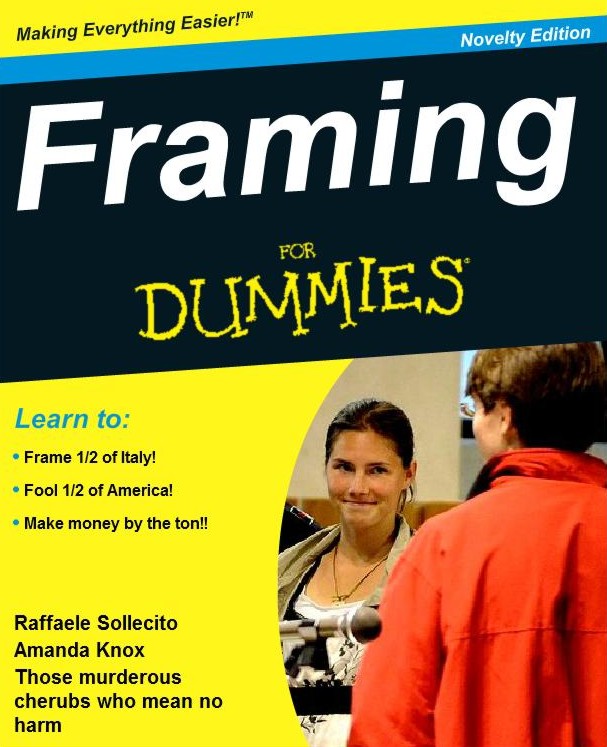
Wednesday, March 12, 2014
Council Of Magistrates In Effect Shrugs At Judge Nencini Answering Loaded Question Of A Reporter
Posted by Peter Quennell
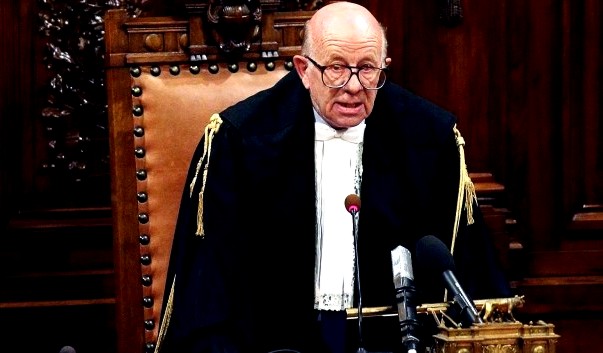
[Cassation judge Antonio Esposito who just faced down a similar complaint to the CSM]
The only ones pushing for the CSM committee hearing today and maybe another one at Cassation were Giulia Bongiorno and a few political friends.
Everybody knows she has once again lost very big and once again is snakily trying to demonize the court rather than gracefully moving on.
The final vote of the full CSM will be announced next week, but it seems a foregone conclusion. The Council will shrug and move on.
Judge Nencini explained himself well for one hour (with his wife, also a judge, present) and probably no magistrate on the Council would have acted so differently, given that the michievous reporter had been asking if the killing of Meredith happened simply because the three had nothing better to do.
Maybe some of the magistrates were thinking “So Bongiorno didnt put Sollecito on the stand? Hmmm, she KNOWS of his guilt only too well”. There is no mood among them to to see the defiant Sollecito who has slimed the system and slimed a much admired judge use a loophole to get himself off.
Jools explained the context of today’s hearing several weeks ago and translated one of the media reports for us today.
Knox, Sollecito judge unlikely to be disciplined by CSM
Inquiry over post-conviction press statements
Rome, March 11 - The Italian judiciary’s self-governing body, the CSM, is likely to drop an inquiry into a Florence judge who broke Italian legal convention by giving press interviews after convicting Amanda Knox and her ex-boyfriend Raffaele Sollecito for the 2007 murder of British student Meredith Kercher in February, judicial sources said Tuesday.
In Italy, judges usually only talk about their verdicts via written explanations published at least a month after they are handed down. But Alessandro Nencini, the head of the panel that sentenced Sollecito to 25 years and American citizen Knox to 28 and a half years at the repeat of the appeals-level trial, gave three interviews to different newspapers that were published February 1.
As a result, Nencini was accused of being biased. One of the most controversial aspects is that in one of the interviews, Nencini seemed to suggest that the fact Sollecito had not allowed himself to be cross-examined had damaged his chances of getting off.
The judge told a CSM commission Wednesday that he did not give interviews, but rather spoke in passing to reporters at the courthouse. He also denied saying the murder was the result of ‘‘kid’s play’’ gone wrong, or expressing an opinion on Sollecito’s defense strategy.
The hearing transcript will be available within a week, when the CSM commission will make its opinion official. The consensus seems to be that Nencini’s statements to the press may have been ill-timed, but not enough to justify a transfer, judicial sources said. Nencini is still not out of the woods, pending the result of justice ministry and Cassation Court inquiries that could lead to disciplinary action against him.
Friday, February 28, 2014
What We Might Read Into Sollecito Lawyer Giulia Bongiornos Final Arguments To The Appeal Judges
Posted by Machiavelli
Under the table & over the top
The picture of a serene-looking Giulia Bongiorno waving a couple of knives in court on 9 January may be visual inspiration to this reflection about what we can understand from the structure and content of her closing arguments.
A very peculiar feature of her arguments was the desperate opening, suggesting to put the investigation ““ and the whole justice proceedings ““ on trial.
The introductive topic of her speech is a quote from a book by Alessandro Satta, a narrative description of the riotous irruption of the mob inside the Revolutionary Tribunal hearing room on Sep. 2. 1792, the defendants are the some of the King’s Swiss guards.
The passage by Satta describes the “horrendous” vision of a hord of sanculots slowly gathering outside the court, Bongiorno compares that to the angry mob in Perugia after the first appeal verdict.
But if you read the same text by Satta a little further, a few lines beyond the snippet Bongiorno was reading, the narration goes on describing how sanculots manage to enter the courtroom, in a force of hundreds ready to lynch the defendants, but they are suddenly halted by an authoritative order of the Judge, and they unexpectedly obey.
Just after that, Satta drops in an explanatory quote from the book Le Tribunal révolutionnaire (by historian Lenotre) saying: “the people understood that these highly educated individuals in black robes would have gone on with the action started by the hords, and they would accomplish it more perfectly”.
It seems like Bongiorno opened her speech with an implicit depiction of the judges and magistrates of Perugia as kind of Jacobin extremists whose task is to “legitimize” the vindictive fury of a pitchforks mob.
The quote she read did not include Satta’s conclusive lines, so that the consequent thought about the judges’ role remained unexpressed and in the background.
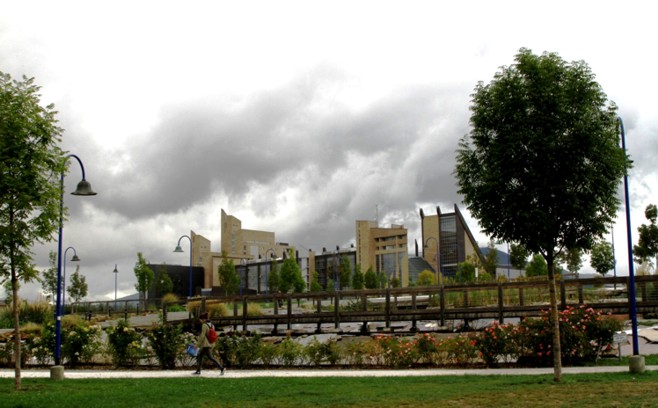
(Photo by Machiavelli_Aki)
A side note about Bongiorno’s arguments: in fact I had the feeling that allusion to implicit subtexts was something that belonged to her speech as a method or a style, it marked the whole of her arguments. You may recall Wittgenstein’s dictum “This work consists of two part, what is written in it, and what is not written in it. The latter is the most important part.”
Such a motto might be apt to address the major feature of Bongiorno’s defensive argument, insofar as she conveyed that something that “couldn’t be talked about openly” was there and that was probably a main argument.
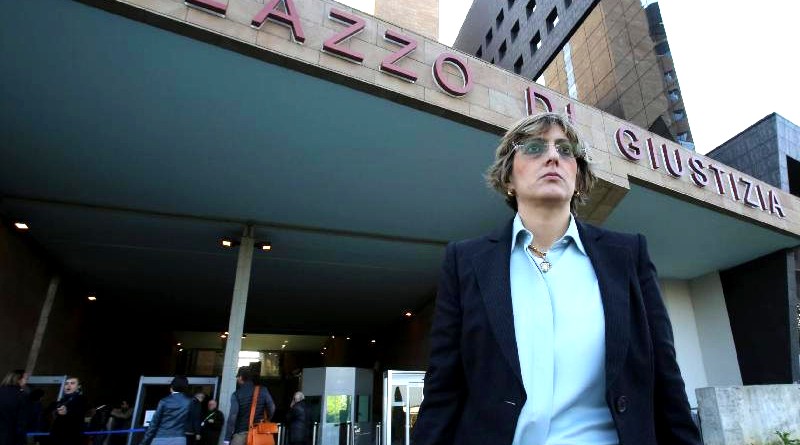
(photo by Ansa)
At first, as I said, she went through a brief emotional recollection of her moments while in Perugia surrounded by a raging mob, and then she unfolded the rest of her introductive section.
The purpose of this bit of revolutionary narrative first juxtaposing the Perugian citizens to Sanculots and the judges to Jacobins, and then, immediately following, a series of accessory arguments all encompassed by an introductive function, all this was clearly intended to set a framework thesis meant to work as a basis for the structure of the whole defensive arguments.
It is in fact a peculiar structure, apparently entirely resting upon one, single elaborate premise.
The thesis she places at the foundation of the entire defensive argumentation is the following: the trial as a whole, as much as its outcome, had been somehow determined and “tainted” from the beginning by events which occurred within a very short framework of time, in the very early days of the investigation, the weeks around the time of the suspects’ arrests.
Bongiorno suggested that only this “short period” ““ the early days of November 2007 - is what matters and the only topic worth of a defence analysis; since this was the time frame within which - according to Bongiorno - everything was decided, this was the time when some “errors” in the investigation occurred, before the point when a veil of prejudice and hatred fell upon people’s hearts and minds like kind of black curtain, preventing from that moment on any fair or rational judgement.
Aggressive Digressions
After the quoting of Satta’s speech, she develops her introduction for a while, branching out into some political-sociological speculations (such as that authorities chose the crime scenario that was most reassuring for the population) as well as some political-anthropological consideration (like the theory that free spirited women are seen as suspicious as a consequence of women empowerment movements).
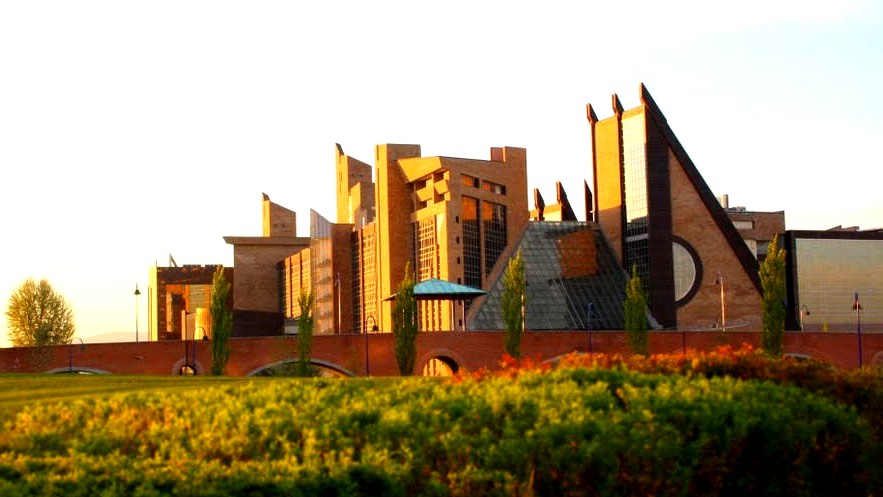
(Palace of Justice of Florence ““ photo by FrederickStudio)
A speech opening as did Bongiorno’s, that is, relying on a set of over-the-top considerations, and apparently so much depending upon one extreme premise, unavoidably conveys a perception of weakness, which is at risk to be transferred to the rest of the argumentation.
Thus, it would be a logical question to ask ourselves: why did Bongiorno chose such a setting and introduction, with several risky, over-shooting arguments?
A perception that the argument was unconvincing was palpable among the public as she was unfolding her theories about Perugian police opting for “political” scenarios and about sexy and free women seen as suspicious because of the women’s political movement.
Scepticism emerged even more openly when she described a scene with Amanda Knox releasing her false accusations while speaking under the hypnotic influence of interpreter Anna Donnino - whom she called “psychic” ““ which triggered some stifled laughs among the public.
Then her long introduction dealt with the unfolding of a rhetorical structure set around the concept of “half”.
I use the word ” rhetoric” in a most technical, non-derogatory sense, to mean the setting of a clear order and concepts designed to be easily remembered, anchored to multiple implicit suggestions, so as to remain impressed in the mind of listeners what is distinctive of the style of Giulia Bongiorno.
Introducing to “˜Halves’
In the previous trial instances she didn’t miss the opportunity to borrow characters such as Jessica Rabbit, Amelie and the Venus in a Fur. I thought she would mention at least a few characters of Disney or the Harry Potter saga this time too, and I was not disappointed as she met expectations on this matter (she did mention Harry Potter, the Eskimo kiss “˜Unca-Nunca’, the Bunga Bunga, the Aladdin Lamp and 9½ Weeks).
She entered the topical part of the introductive section saying “˜basta’ to always focusing on Amanda’s personality alone, while considering Raffaele just Knox’s other “half”, he is not half a character, he should not be seen as reflexion of Knox.
The curse of being “half” chases him also, meaning there are only “half pieces of evidence” against him. And this is the rhetoric structure envigorating the arguments after the introduction, the concept of “half” .
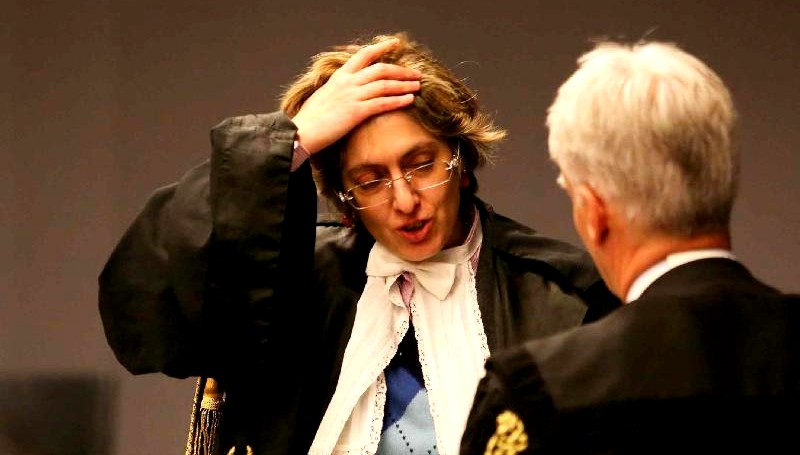
Only half pieces of evidence, almost a half admission, or the clear suggestion that there is maybe one “other half” of something (of culprits?) somewhere else, something not to be said, something that is not here.
The concept of “half” recurs and somehow pervades her defence, we should say something more about later on because she picked it up also in the subsequent hours of speech.
Some videos from the Florence trial available may still be available at the Sky site.
Primordial Fossils
Only after recollecting all these things in the “˜aggressive digressions’ over the introductive part, she goes on with a ponderous section which is the main part of her argumentation.
It’s a topic directly stemming from the introductive themes and premises, in the sense that this main part focuses on and blows up events of the first four days of investigation. It zeroes on few small details of the investigation history, the previous introductive part functionally working to justify the choice and to limit the argumentation to these topics.
Something the listener would notice from this first and main part of the arguments, as everyone well understands, is that these arguments are arranged in a peculiar type of architecture. A choice that makes crystal clear the actual state of the defence’s options.
The defence strategy is to focus attention on the supposed flaws in evidence collection at the beginning of the investigation, and not on the evidence set itself.
Bongiorno’s arguments do not map out the evidence set array. They do not devolve an effort of analysis in proportion to the actual weight of the of pieces of evidence.
The bulk of her speech in fact can be summarized as a criticism of some historical happenings ““ what she sees as such ““ which allegedly occurred within a very small time frame. She devoted hours to attacking the beginning of the investigation, early errors such as that the shoe print that had been wrongly attributed to Sollecito on a first assessment.
It appears this attack against the early procedures of the investigation was really considered to be the most effective weapon the defence had left.
The “˜topics’ Bongiorno addressed in this attack as “˜main points’ of evidence against Sollecito, are only three: the wrongly attribute shoeprint, Sollecito’s side-tracking the investigation, and “˜the knife’ (a topic which gets picked up again later, with a long discussion focused on the blade length).
In the same “˜knife’ topic she included DNA discussion, in a connected digression she dealt with the bra claps, called all the scientific evidence collection “˜the mother of mistakes’ and offered again the known criticism of Stefanoni’s alleged “suspect-centred”.
Later in her speech, she dealt with the other evidence topics, parroted the “˜principles’ expressed in the Conti & Vecchiotti report, offered the known arguments about the bathmat print, etc.
But the bulk of her defence hinged around those “˜mistakes’ in the early investigation phase, this was the actual core of her argumentation, while the other pieces of evidence were dealt with summarily, I had the impression they were almost treated as accessories.
It was clear above all that the defence was not battling the structure of the evidence actually existing today, they were battling a minuscule part of it, or better they were battling something else, something which is not directly the evidence, but rather some historical foundations of the accusation building.
Basically what Bongiorno conveyed is, the fighting terrain was the “˜investigators’ errors’, their “˜excesses’. That is, they were not actively contending Raffaele’s innocence any more.
The implicit content was rather obvious to the listener: a direct claim of Sollecito’s innocence had been already abandoned, that territory was left beyond the lines and the defensive front had been drawn back.
The topic now was not innocence, but rather how the accusation had been unfair and excessive.
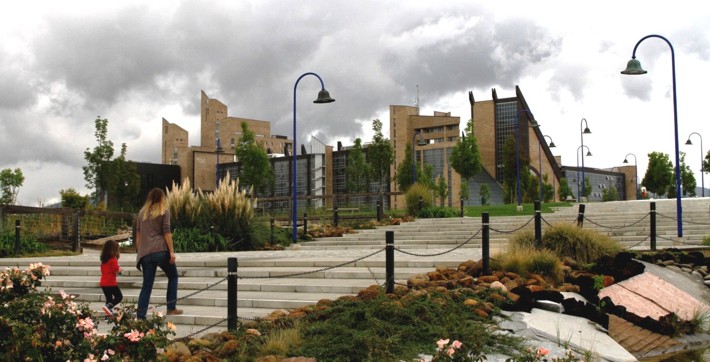
At her opening, the quote of Satta was a device to draw attention to the events at the “origin”, so as to prepare listeners for the fact that defence arguments will be focused on what happened during the moments before the “black curtain” came down.
Hence the a long introduction starting from an image of the fury of a mob of sanculots, a narrative on this theme: people were willing to convict the defendants immediately and judges were legitimizing people’s violence.
She oriented the discussion towards the topic of early prejudice and excesses, so to justify the fact that she will talk about the early phases rather than the evidence set, and then she introduced the leit-motiv of the “half”.
This means, rather than disputing the pieces of evidence, Bongiorno wanted to set a “trial of the investigation”, she zeroed on just a few details actually not having much relevance in the actual evidence set.
She talked at length about elements that are kind of fossils ““ like when she went on discussing about the number of circles in the sole of Guede’s shoeprint ““ putting the alleged “errors” in the course of the investigation on trial, and her speech at times sounded as if it was a lecture about dinosaurs, recalling curious things now extinct.
The explicit function of her introduction was to justify her setting aside the evidence set, downplaying it by framing it into a historical moment, maintaining that it was collected and interpreted when investigators were already beyond the “black curtain” of bias, therefore tainted by prejudice, while judges were like sycophants before an angry mob.
The purpose behind the Black Curtain
The implicit, most important function of the introduction was accomplished via the concept of “half” and all the subliminal suggestions attached.
We should ask ourselves: is it reasonable to believe Bongiorno was so naïve to expect that the court may accept a theory about a dismissal of evidence in limine?
The answer is no. Bongiorno knew perfectly well that her preliminary criticism of the investigation would not lead to a dismissal of the evidence.
Bongiorno also knew that the series of preliminary arguments she would offer would be considered ineffective by judges. Such as that the knife DNA should be seen as unreliable preliminarily, that Stefanoni’s work lacked “transparency”, that Vecchiotti and Conti’s “method” should be taken at face value (Bongiorno knows C&V’s intellectual honesty was called manifestly questionable by the Supreme Court ), that this and that allele in the bra clasp DNA should not be considered because, etc.
She also knows that this court will not allow pieces of evidence to be considered separately from each other in a parcelled out way, and that imperfection of single pieces themselves do not work as a logical argument. Even less could she dismiss the evidence based on political and anthropological theories.
From the fact that she was setting afoot on a trial of the investigation instead of battling the evidence, the rational listener infers that she is well aware of the weakness of her position, since it implies that the evidence set as the battleground would be indefensible. She needs to search for another terrain of attack, a different structure, as the only possible move.
But there is also another implication. She does need to engage and draw attention to areas where she could “win” something, but this also means that her intent was to “soften” the accusation, to work it out at the flanks rather than face it frontally; to reduce the size of some fundamentals, the “excess” of the accusation.
In other words, to shorten the sentence. And if possible, to separate Sollecito’s position from that of Amanda Knox, albeit within the boundaries of her client’s plea.
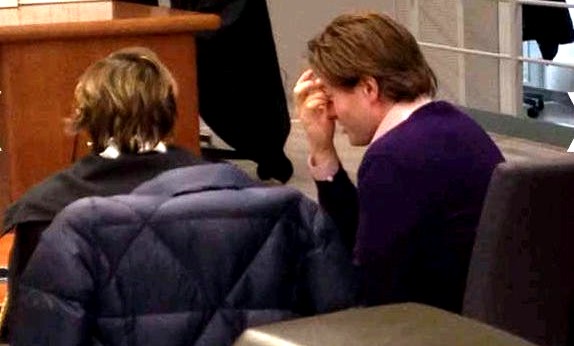
Her strategy of attack had a reason, that was to try to soften the accusatory attitude against Sollecito. Besides being risky (may sound extremely unconvincing) the strategy was also loaded with implicit meanings.
What was most stunning to me ““ as it was a recurrent topic through her whole speech ““ was the concept of “half”. She picked up this introductive theme several times, such as while speaking about the medical findings explaining that only “half” the length of the blade would be used, if a knife so large as Sollecito’s kitchen knife was used, saying that, in this event, this would mean the perpetrator did not intend to kill and killing was the effect of “mistake”, an involuntary movement.
The importance of the length of the big blade and its “half” was emphasized by a waving of knifes, in a quite impressive theatrical performance: “Either the big wound was made by a smaller knife” that was held by “someone else” or the knife was “plunged only by half” showing there was no intent to kill.
All this is to be coupled with the fact that, as said above, she devoted a main portion of her 6-hour speech to discussing things that are fossils, elements not existing any more.
She dealt later with other pieces of evidence too, though in a way that seemed somehow marginal, and she did not deal with some of them at all - the inconsistencies in Knox’s account, for example, were left completely out.
She was not that kind with Knox’s written memorials either, calling them “farneticanti” (waffling, raving).
I noted her complaining about Raffaele being “halved”, as his character is portrayed as depending on Amanda’s and thus seen as equally guilty insofar he was Amanda’s half ““ and this effect is somehow transferred to pieces of evidence.
Bongiorno’s rhetoric emphasizes that Sollecito was accused on “half” pieces of evidence (you perceive that the metaphorical repeating of “half” implies that evidence actually exists, “by half”, and at the same time this complaint about being seen as “half” of something is a subliminal suggestion that the defendants should be considered separately, and their charges as well, thus maybe their responsibilities if considered separately may be different; and when it comes to discussing how the murderer used only half of the blade, the subliminal suggestion is bring down the charge by half, involuntary event/manslaughter versus voluntary murder).
The Mark of Infamy
Giulia Bongiorno picked on the investigators and acted as if she was putting the investigation on trial not because she thought that this would lkead to the defendants being found innocent, but exactly for the opposite reason, because she expected them to be found guilty.
Insults against Prosecutor General Crini, against witnesses and and gratuitous accusations are a risky path but they are also an overt attempt to “soften” the investigation scenario, rather than fight it frontally.
She had no hope to make her client look innocent, her only hope was to soften the strength of the accusation, to make him look less guilty, not so bad as the investigators saw him.
She pursued this in two ways, by suggesting that he should not be seen as the “half” of another perp but rather his responsibility should be considered separately, only that evidence which proves directly against him (Bongiorno repeatedly pointed out that Knox did not utter his name in her interrogation and statement), his actual responsibility might be much lesser than the charge for which he is accused.
The other arm of the defence’s pincer move, the second way to try diminish the accusation, was to portray the investigators in bad light. The “˜excess’ of accusation was to lay blame on investigators for their bias and errors.
Bongiorno’s attack against the investigation might be intended to achieve a psychological effect due to comparative process.
If you consider how the police are responsible for “˜excesses’ and disputable behaviours, you may think the investigators have been prone to gross mistakes that lead to exaggerating Sollecito’s implication, thus the accusation should be not be taken at face value and should be corrected. Maybe the correct assessment of evidence proves he not as much implicated as they had thought.
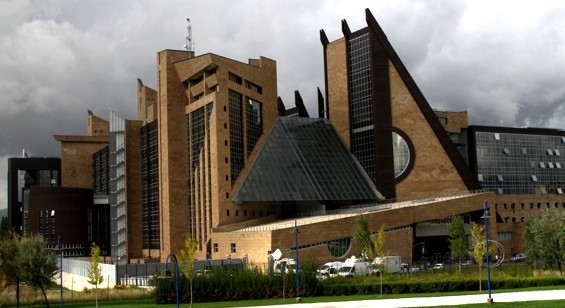
This seemed to be Sollecito’s own defence strategy, albeit implicit, since Bongiorno must restrain her action within the boundaries of her client’s plea.
In order to follow her strategy, however, Giulia Bongiorno decided to take a few steps which must be pointed out as particularly reprehensible and infamous.
I was surprised and stunned by those action because they qualify the character of Giulia Bongiorno as far worse than I thought, I really did not expect her to stoop so low.
The infamous part of Bongiorno’s speech is her gratuitous name calling and defamatory attack against Anna Donnino, her attempt to smear her professional reputation and the rude insult in calling her a “˜psychic’.
In real life Anna Donnino is a very respected professional, she has been working for the Questura on tasks of interpreter and language mediator (not as a “˜translator’).
She is also an intelligent person, she is precise and expresses herself with the utmost clarity as her lucid testimony shows.
She is known not only for having unquestionable professional ethics, but also she has an excellent reputation as a person; she is honest and humane and known by everybody for her extremely reassuring, protective temperament, and for her expertise and excellent performance of working with people.
She would help immigrants in difficulty to express themselves and understand their rights and was priceless helping the police to obtain precise information in their investigations.
As an expert in chuchotage and linguistic mediation from two foreign languages, the professional quality of her work is excellent. Her training and work is of interpreter and language mediator although sometimes shee is given translating tasks such as the translation of recordings and wiretappings.
The Questura of Perugia used to hire “˜language mediators’ at the time. You don’t know what a language mediator is? See a university course for a degree in Language Mediation.
The Questuras of some bigger cities also have “˜cultural mediators’ in addition. They are mother-tongue trained to deal with African or Chinese immigrants (one of the many young people having their internship as cultural mediator in a Questura is shown here.)
To me, this defamatory attack against Donnino was most disturbing. By doing this Bongiorno came across as surprisingly mean, I’d say what she did was really infamous.
Indeed this was not the only virulent attack, it came after insults to the city of Perugia as she was comparing its citizens to a mob of blood-thirsty fanatics.
This attack too is also particularly vicious, since it exploits, inflames and is subtly synergic with the tones of lies and prejudices disseminated by a perfidious propaganda strategy.
But at a certain point, Bongiorno focused the defamation against one person. As she unfolded a narrative about Anna Donnino acting as a “˜psychic’ who managed to hypnotize, to gaslight Knox to the point of inducing a state of trance in which she mistook a dream for reality, some people couldn’t help laughing in the courtroom.
But even if we consider the surreal and comical rather than the convincing effect, the defamatory intent stands out as reprehensible and humanly vicious.
This is because, as I said above, these particular insults were directed against a person distinguishable for her being a most decent, honest and trustworthy character, and also ““ a further reason ““ because of the recent events for which this person experienced personal suffering: Anna Donnino, a mother of teenagers, has been struck with cancer, and has undergone surgery.
She is under treatment but still currently remains in very bad health.
The attack against Anna Donnino is an action that rebounds as an ugly stain on the reputation of those who launched it. A young man from Perugia created a Facebook group to express a the citizens’ “hate” for those who lead a defamatory campaign of lies against the city. He collected over two thousand likes within three days.
Some of the comments were about Bongiorno’s insults against the city and against respected citizens, pointing out her outrageous hypocrisy since Giulia Bongiorno poses as a campaigner for the respect and dignity of women.
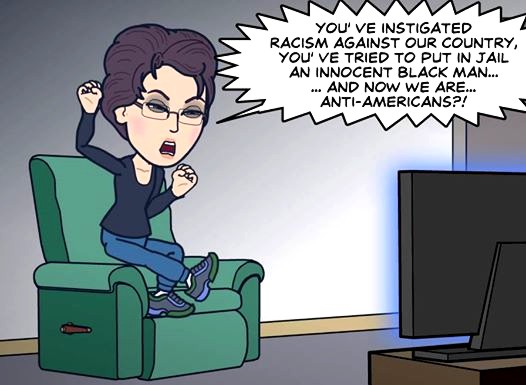
(a StripBit comment by a poster on a Facebook group)
Criticism of Giulia Bongriorno pointing out her hypocrisy is actually not a novelty, it has appeared long since in the press and on the internet.
But it’s hard to understand how someone like her, promoting an image of herself as an advocate for women and for correctness and respect in language and culture, could take such a an egregiously visible false step, come out with such stupid stereotypical rants, only for what looks like an awkward and useless cause.
Conclusion
A note for the record: we may recall Bongiorno has also attacked the Perugian police officers, citing the recording of some of their phone conversations in which they say bad words about the Sollecito family.
We can understand her outrage (at least we could, if only she were not the hypocrite she is) but at the same time we can’t fail to notice that she “forgot” to mention another half of the phone call recordings.
Specifically those where the members of the Sollecito family were speaking about the police officers; and the kind of language they were using, while attempting to plot “˜under the table’ help from some politician.
Expressing their intent to “˜scorch’ officers and “˜destroy’ magistrates, and one person even suggested that if he met Monica Napoleoni on the road, he would kill her by “˜running over her with the car’ then flee without telling anything, pretending that nothing happened.
Never mind.
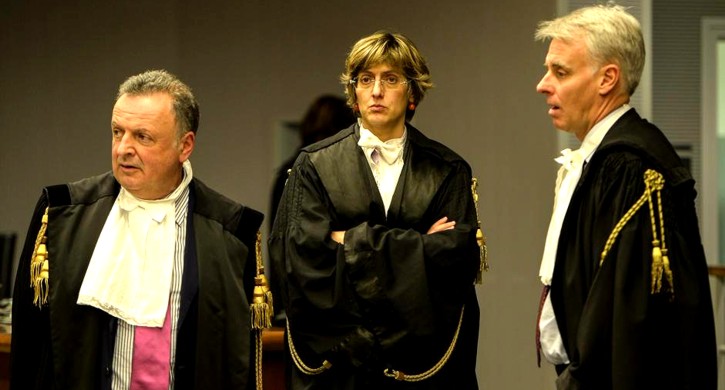
After these last sparkles and the knife waving Bongiorno’s performance was over. In the following day’s hearing it was Maori’s turn. As a really last resort, he was taking on the task of disputing evidence in a more “traditional” way, objecting to points of evidence.
Possibly this revealed even more the extreme weakness of the defensive argument (a commenter called it “˜pathetic’). I did not listen to his argument myself, I only notice that he did not get much space neither in the press nor in the pro-Knox commenting sites; this might be a clue of how unconvincing he might have been.
One thing that however I could learn about it, is about the feeling, the perception that Maori pointed out even more the separation between the two positions of Amanda Knox and Raffaele Sollecito.
A hint about this comes in the words of a journalist who was questioning Alessandro Nencini in the lounge immediately after the verdict: the journalist pointed out how Sollecito defence “tried to split the positions of the two accused”.
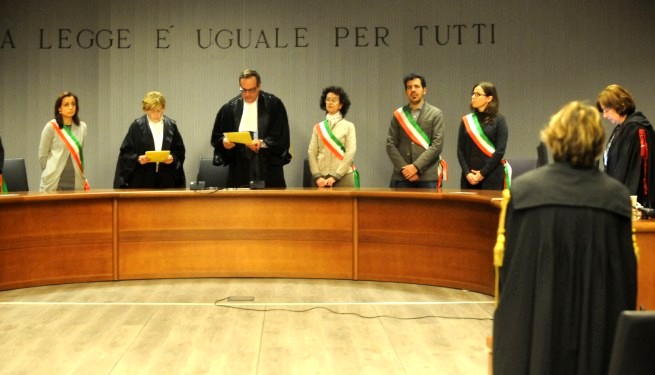
This mild attempt of a separation was the last act by the defence. As for Raffaele Sollecito himself, we were left with his rather different claim, his book where he described himself as sticking to a “˜honour bound’.
He reportedly bragged about this also with his ex-girlfriend Kelsey Kay, who described him as feeling very entitled because of his loyalty to Amanda Knox and believing she owes him a vital a favour; but Knox won’t even respond to his messages.
Then, we had his final admission in an interview that his friendship with Amanda Knox has “˜deteriorated’, because apparently Knox in practice no longer supports him as before.
If his defence advisors understood that they needed to somehow “˜separate’ his position from Knox’s at any cost, despite his plea, to suggest he may be implicated but just “˜less’ guilty, we may only agree with them on this. It would also be convenient for him to confess even if he shared the same degree of guilt of Knox.
Sadly, instead he still felt compelled to offer further lies and changing stories such as”˜I noticed no blood on the bathmat’ when questioned by Kate Couric; he offered again a story of pricking Meredith’s hand while cooking together at the cottage.
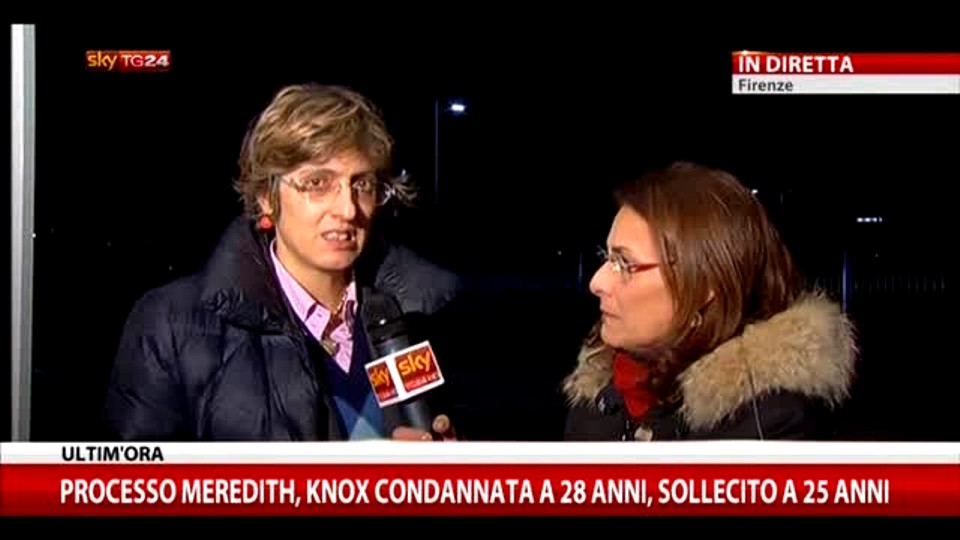
Other murderers, who committed even more heinous crimes, have recovered and rehabilitated themselves after time spent in prison; even some of those deemed among the worst serial killers managed to do this by expressing remorse ““ for example the rather psychopathic “˜Ludwig’ (Furlan & Abel) killers.
Sure after the years he will spend in jail for the gang-like crime he is found guilty of, there would be a possibility for a “˜casual murderer’ such as he is to be perceived as rehabilitated. But to see him as “˜less guilty’ or as “˜rehabilitated’ would be impossible as long as he remains silent or denies.
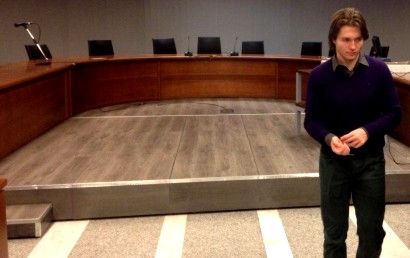

Tuesday, February 04, 2014
Defense Dirty Tricks: Did We Just See Yet Another One, An Attempt To Compromise Judge Nencini?
Posted by Jools
Judge Nencini offers corrections
This is my translation of a statement from Judge Necini carried by the Florence GoNews website.
“In relation to the press articles that reported my statements on the trial for the death of Meredith Kercher I intend to point out that there has been no interview organized or pre-arranged.
I ran into some journalists in the corridors of the courthouse who told me of the rumors and speculations that were being circulated on the duration of the deliberation session.
I then had a brief talk with them meant, in my intention, to clarify possible misunderstandings. In this I accept responsibility, reaffirming that I did not agree to disclose in any way the reasons for the sentence. In particular, I have not expressed any opinion on the strategy procedure followed by the defence of the accused.
In fact the only reference to that matter, reported in the article that appeared in Il Messaggero, is one in which I stated that the accused were defended in the process to a ‘very high standard.’
If my words have generated misunderstandings on this point and on the absolute legality of the choice of an accused to make spontaneous statements I regret it.
These explanations are dutybound for the respect I owe to the people who participated in the process with me and to the [Law] System of which I’m proud to be a part of; as well as for consistency in my professional history, with over thirty years of work carried out without spotlights and without interviews.”
Context for those corrections
This is in relation to the previous days articles claiming Judge Nencini supposedly gave an “inappropriate” interview to the press.
In very short order three or four lay members of the Superior Council of Magistrates (CSM) laid a complaint about non-appropriate conduct (under Art. 6 of the CSM rules) for a presiding appeal court judge to give press interviews commenting on the motivations reached by the judges on any sentence before its official publication.
Not surprisingly, the first people to complain were Bongiorno and Maori (grasping at straws, much?!!) and then to follow were these three or four lay members of the CSM, who happen to be also members of the centre-right political party “Forza Italia” (Berlusconi’s party).
As a result of the complaint made by these people, the Justice Minister, Annamaria Cancelleri, ordered an inquest on the allegations against Judge Nencini which could have led to his reprimand for disclosing details of the verdict reached to the press.
Personally, I think this all results from the desperation of Sollelcito’s defense and they have erncourgaed the others to instigate it. Making a meal out of nothing, in the hope that the whole appeal trial gets thrown out.
And let’s face it, it wouldn’t be difficult for Bongiorno to find some of Berlusconi’s people that are always looking for ways to attack members of the judiciary given Berlusconi’s hatred for the system. Just my opinion…
In any case, the allegations seem to be false, Judge Nencini actually didn’t say much, and the inquest will prove it, but in the meantime the press is concentrating on this rather than the hopeless work the defense produced. This maybe is the whole objective.
The later, longer interview
The interview by Fiorenza Sarzanini with Judge Nencini the following morning is claimed to be quite legal, because the decision of the court had been published the previous evening.
Andre Vogt kindly posted a very accurate translation on The Freelance Desk, and as it will scroll down soon and be hard to find, we can repost the full interview here.
Posted 1 February
Italy’s most influential newspaper, the Corriere Della Sera, this morning has published a fascinating long interview with Judge Alessandro Nencini about his reasons for convicting Amanda Knox. The interview was done by one of the newspaper’s most veteran crime and investigative reporters, Fiorenza Sarzanini. Click here to read the original.
HEADLINE: Amanda and Raffaele: The Judge Speaks
SUBHEAD: “I have children too; it was a huge burden.”
SUBHEAD2: “The defense had asked to separate the positions of the two accused, but Raffaele would not allow himself to be questioned.”
By Fiorenza Sarzanini
“I feel relieved because the moment of the decision is the most difficult. I have children too, and handing down convictions of 25 and 28 years for two young people is a very hard thing, emotionally.”
It is 10 am the day after the verdict and Justice Alessandro Nencini is in his office. The President of the Florentine Court of Appeals, which two days ago found Amanda Knox and Raffaele Sollecito guilty of the murder of Meredith Kercher, knows that the decision will “open up new debate, especially in the media”, but that is exactly why he agreed to explain how the verdict was reached.
You deliberated in chambers for 12 hours. Was the judicial panel divided?
“The case files took up half of the room. There are 30 expert reports. The lay judges, who aren’t court staff, had to read all the documentation to reach a joint decision, as is expected in the appeals court. You have to review all the documents, think about them, and reason. We did that using all the time that was necessary, and taking into account the fact that the victim was also a young girl.
And then the decision was unanimous?
“I spoke of a joint decision. I can say that in all these months and in particular during the last session of deliberations, we carefully considered the gravity of a verdict that involves young people and their entire families. This is a case that has consumed many lives.”
Yours was a narrow path, the Court of Cassation had urged you to remedy the Perugia appeal decision that had acquitted the two accused.
“Not so, we had maximum flexibility. The only restriction was that in the case of acquittal, we would have to have give reasons based on logic. There was no other binding restriction.”
Not even with regard to the decision handed down in Rudy Guede’s case?
“Effectively the specifics of the case was this: there was a person already convicted via fast-track, and definitively, for concourse in the same homicide. The Court of Cassation was asking us to consider who participated and their roles. We could have said that the two accused weren’t there, and then provided convincing reasoning, but we did not believe this to be the truth.”
Why didn’t you question Guede?
“For what purpose? He has never confessed and even if we had called him, he had the right to remain silent. We didn’t think it was necessary. Rather, we felt it was important to study the other aspects more in depth. In fact we requested an expert report and heard witnesses about which there were doubts. That is the role of the appeal judges. In four months, we’ve been able to arrive at a result.”
Sollecito’s lawyers had asked you to split the defence.
“We’ll explain the point more in the reasonings, where we will explain why we rejected that request. In any case, Sollecito did not want to be questioned during the trial.”And this influenced your choice to convict him?
“It is the defendant’s right, but certainly it removes a voice from the trial proceedings. He limited himself to making spontaneous declarations, saying only what he wanted to say, without being cross examined.”
Over the years, various motives have been speculated. What idea did you yourselves form?
“We convicted and we will explain it explicitly in our reasoning. For now, I can say that up until 20:15 of that evening, these young people all had different plans, then their commitments fell through and the occasion for this to happen was created. If Amanda had gone to work, we probably wouldn’t be here.”
Are you saying that the murder was just a coincidence?
“I’m saying this was something that unfolded between these young people. There may have been coincidences, and we’ve taken it into the reasoning. I’m aware this will be the most debatable part.”
Cassation demolished the acquittal. Will you as well?
“We are not going to mention it. We simply have to focus on the decision in the first instance (Massei) which we confirmed, on the facts.
And you don’t believe that there were errors?
“I didn’t say that. Some I believe there may have been and I’ll point them out.”
You convicted Amanda Knox, but didn’t issue any precautionary measures against her. Why?
“She is legally in the United States. At the moment of the offence she was in Italy to study and she went home after having been acquitted. She is an American citizen. The problem will arise when it is time to carry out the sentence. For now I don’t believe that such a measure wouuld have been necessary.”
So why then have you confiscated Raffaele Sollecito’s passport?
“It was the agreed minimum. In these cases such measures serve as prevention. We want to avoid that he makes himself impossible to find during the period of waiting for a definitive judgment.”
And you believe being forbidden to leave the country is enough?
“Yes, that seemed more than sufficient to us. If there are other developments later, we will consider them.”


